Self Watering Plant Pots
Is Self Watering Pots Good for Orchids
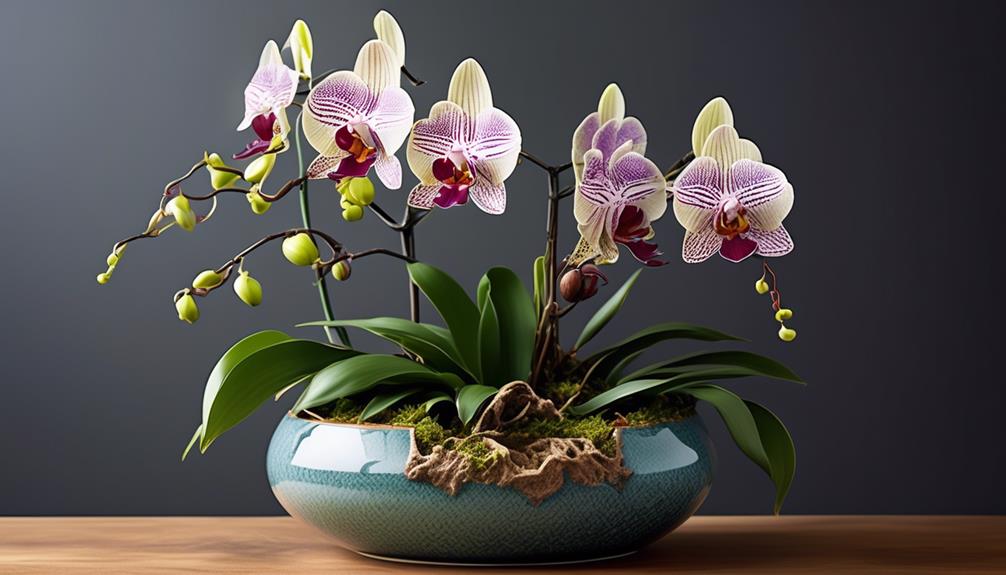
We all know the struggle – trying to balance our busy lives and also take care of our houseplants. Did you know that over 75% of orchid owners struggle with providing the correct water amount for their plants? That’s when the benefits of using self-watering planters come into play.
But are they really good for orchids? As we explore this topic, we'll uncover the benefits, potential drawbacks, and best practices for using self-watering pots with orchids.
So, are self-watering pots the solution to our orchid watering woes, or do they pose a risk to the delicate balance of orchid care?
Key Takeaways
- Self-watering pots maintain consistent moisture levels, reducing the risk of over or under-watering.
- Self-watering pots are efficient and minimize water wastage.
- Self-watering pots provide a low-maintenance solution for orchid care.
- Close monitoring of watering frequency and orchid health is necessary when using self-watering pots.
Understanding Self-Watering Pots
Self-watering pots, also known as self-watering planters, are designed to provide a consistent and controlled water supply to orchids and other plants by utilizing a reservoir system. This self watering technology operates on the principle of capillary action, where the plant draws water from the reservoir through wicking material into the soil. This ensures that the plants receive water as needed, preventing both overwatering and underwatering. The reservoir system also allows for a more stable root environment by maintaining consistent moisture levels, which is particularly beneficial for orchids that are sensitive to water fluctuations.
Understanding the self-watering technology is crucial for optimizing the watering frequency. Unlike traditional pots, self-watering pots require less frequent watering due to the reservoir's ability to store water for extended periods. The frequency of filling the reservoir depends on factors such as plant type, environmental conditions, and pot size. Orchids, for instance, often thrive with less frequent watering, and the self-watering pots can efficiently meet their moisture requirements, reducing the risk of root rot and other water-related issues.
Benefits of Self-Watering for Orchids

When cultivating orchids, the use of self-watering pots offers numerous advantages that contribute to the overall health and vitality of the plants. The benefits of self-watering pots for orchids are substantial and can significantly impact the growth and blooming of these delicate flowers.
Some of the key advantages include:
- Consistent Moisture Levels: Self-watering pots maintain a consistent level of moisture, ensuring that orchids receive the appropriate amount of water at all times. This consistency is vital for optimal growth and blooming, reducing the risk of over or under-watering.
- Efficiency Comparison: Compared to traditional watering methods, self-watering pots are highly efficient in delivering water to the orchids. This efficiency results in less water wastage and a more sustainable approach to orchid care.
- Reduced Maintenance: Self-watering pots require less frequent watering and monitoring, providing orchid enthusiasts with a low-maintenance solution that still yields impressive results.
The efficiency and practicality of self-watering pots make them a valuable investment for orchid enthusiasts, contributing to the overall success and enjoyment of cultivating these exquisite plants.
Potential Drawbacks of Self-Watering
While the benefits of self-watering pots for orchids are well-documented, it is essential to carefully consider potential drawbacks that may impact their effectiveness in orchid cultivation.
Potential Drawbacks of Self-Watering for Orchids
When utilizing self-watering pots for orchids, there are several potential drawbacks to consider, including overwatering risks, maintenance challenges, and the impact on orchid health.
| Drawbacks | Description |
|---|---|
| Overwatering Risks | Self-watering pots can lead to overwatering if not properly monitored, risking root rot. |
| Maintenance Challenges | Cleaning and maintaining self-watering systems can be more complex compared to traditional pots. |
| Watering Frequency | Self-watering pots may not always match the specific watering needs of different orchid species. |
Self-watering pots may not always align with the unique watering requirements of various orchid species, potentially impacting their overall health. Additionally, the maintenance of self-watering systems can be more demanding, and if not properly managed, they can lead to overwatering issues, posing a risk to the orchids' root health. Therefore, while self-watering pots offer convenience, it is crucial to carefully assess their compatibility with specific orchid species and to closely monitor their impact on watering frequency and orchid health.
Orchid Watering Requirements
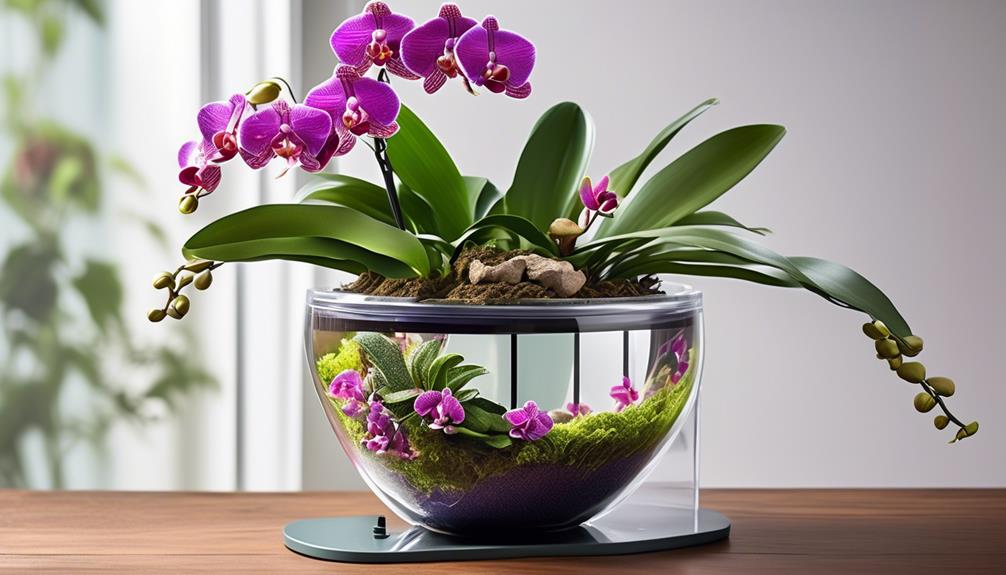
Understanding the specific watering requirements of orchids is essential for maintaining their health and promoting optimal growth. Orchids have unique needs when it comes to watering frequency and moisture levels, which must be carefully managed to ensure their well-being.
Orchid watering frequency:
- Orchids generally require watering about once a week, but this can vary depending on factors such as the type of orchid, the potting medium, and the environment.
- Overwatering can lead to root rot, while underwatering can cause dehydration and hinder growth. Finding the right balance is crucial for their health and vitality.
Moisture levels:
- Orchids prefer a moist environment, but they also need good drainage to prevent water from accumulating around their roots.
- The potting medium should be well-draining to avoid waterlogged conditions, which can suffocate the roots and lead to disease.
Monitoring and adjusting:
- Regularly checking the moisture levels in the potting medium and adjusting the watering frequency accordingly is vital for orchid care.
- This requires attentiveness and a willingness to adapt to the specific needs of each orchid.
Mastering the art of orchid watering involves a deep understanding of these factors and a dedication to providing the best possible care for these exquisite plants.
How Self-Watering Pots Work
To ensure optimal moisture levels for orchids while avoiding overwatering or underwatering, understanding how self-watering pots work is essential. Self-watering pots typically consist of a water reservoir, a wicking system, and a soil container. The watering mechanism is based on capillary action, where the wick draws water from the reservoir into the soil as needed, maintaining consistent soil moisture. This system effectively prevents waterlogging, a common issue with traditional pots, by allowing the plant to absorb water as required. The wicking system also ensures that the soil moisture is distributed evenly, providing a stable and balanced environment for orchid roots.
| Water Reservoir | Wicking System | Soil Container |
|---|---|---|
| Holds excess water | Draws water into the soil | Contains the orchid's root system |
| Prevents waterlogging | Utilizes capillary action | Maintains optimal soil moisture |
| Minimizes watering frequency | Regulates water uptake | Provides stability and balance |
Understanding the mechanism behind self-watering pots can help orchid enthusiasts create an ideal growing environment for their plants. This knowledge empowers growers to maintain consistent soil moisture levels, promoting healthy orchid growth and blooming.
Choosing the Right Self-Watering Pot
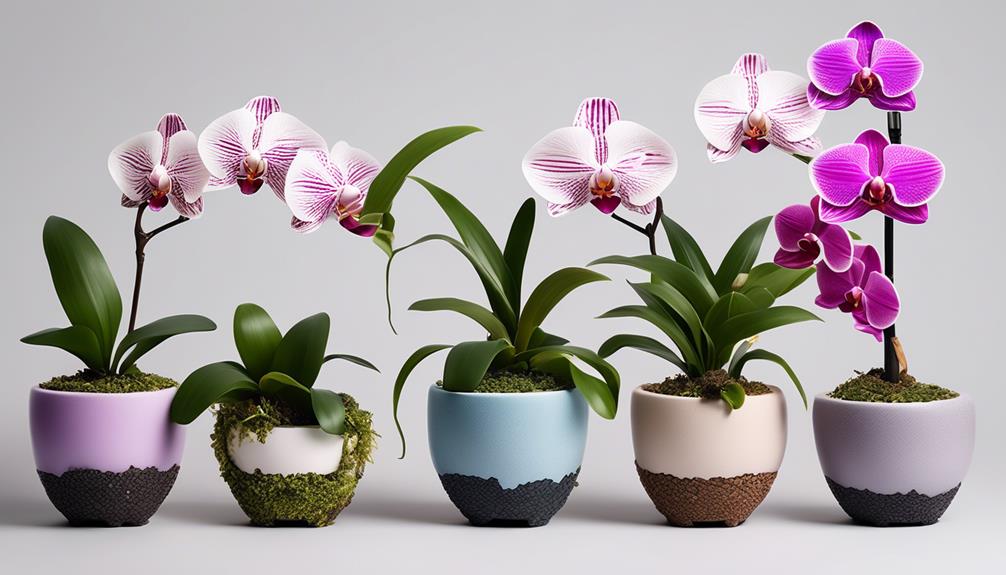
Selecting the appropriate self-watering pot is crucial for ensuring the optimal growth and health of orchids. When choosing the right self-watering pot for your orchids, several factors should be considered to provide the best environment for their growth and to enhance the aesthetic appeal of your space.
- Choosing proper materials:
- Opt for pots made from breathable materials like clay or unglazed ceramic to allow for proper air circulation and prevent waterlogging, which can lead to root rot.
- Look for pots with a transparent water reservoir to easily monitor the water level and prevent overwatering.
- Decorative options:
- Consider the aesthetic appeal of the pot to complement the beauty of the orchids, as well as the overall décor of the space.
- Explore different designs, colors, and finishes to find a self-watering pot that adds to the visual appeal of your orchids and living space.
When you prioritize the selection of the right materials and consider decorative options, not only will your orchids thrive, but you'll also create an environment that enhances your overall enjoyment of cultivating these exquisite plants.
Best Practices for Orchid Care
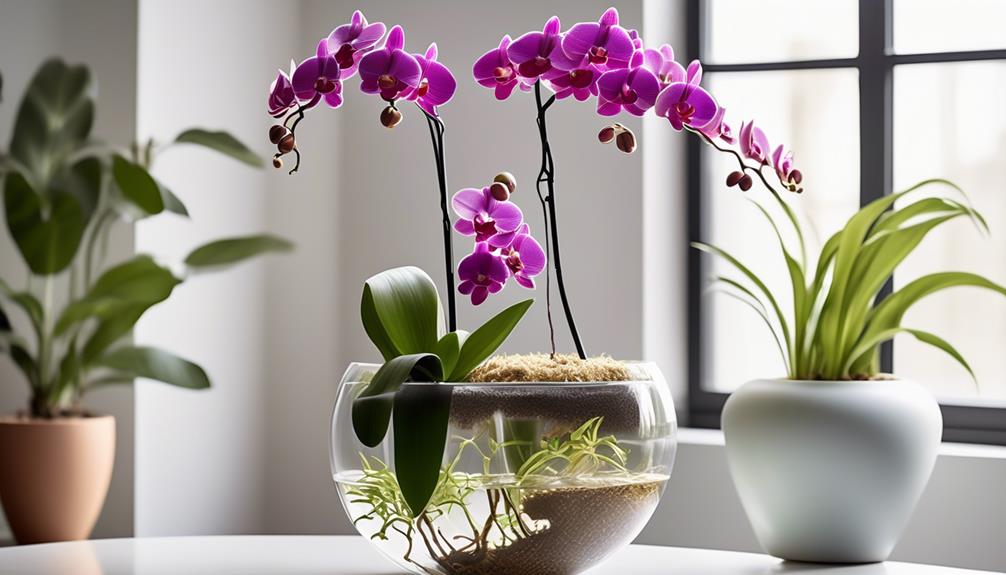
When caring for orchids, it's essential to maintain proper watering, humidity levels, and lighting conditions to promote healthy growth and vibrant blooms. Orchids thrive in environments with consistent moisture levels. It's important to water orchids early in the day, allowing excess water to drain freely to prevent root rot. Humidity levels between 50-70% are ideal, and placing a tray of water and pebbles near the orchids can help maintain adequate moisture. Additionally, ensuring proper lighting is crucial. Orchids typically require bright, indirect light to flourish.
Orchid fertilization is another key aspect of care. Using a balanced fertilizer, with an N-P-K ratio of 20-20-20, is recommended. Fertilize the orchids weekly during the growing season, and reduce to monthly during the dormant phase. Proper temperature control is also vital. Most orchids thrive in temperatures between 65-75°F during the day and slightly cooler at night. Maintaining these conditions will support robust growth and abundant blooms in orchids.
Self-Watering Vs. Traditional Pots
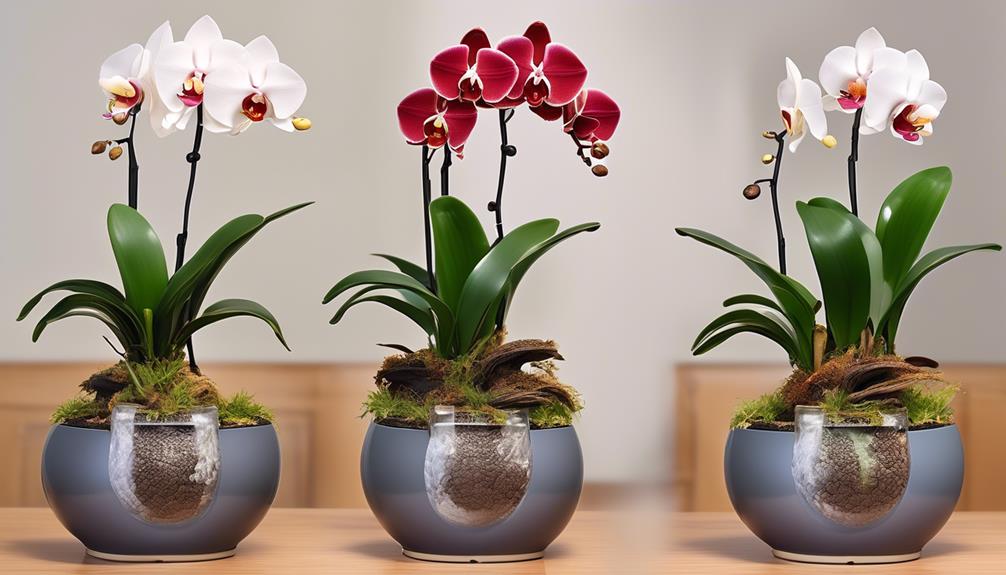
When comparing self-watering pots with traditional ones, we find that the efficiency of watering is a key point of interest.
The ability to control moisture levels in self-watering pots can significantly impact the overall health and growth of orchids.
Research suggests that the impact on orchid growth in terms of root development and overall vitality is an important consideration when deciding between these two pot types.
Watering Efficiency Comparison
In our study, we compared the watering efficiency of self-watering pots with traditional pots for orchids. We found that self-watering pots significantly reduced watering frequency compared to traditional pots, due to their larger water reservoirs.
The pot size also played a crucial role, as larger pots retained moisture better, promoting healthier root systems and reducing the risk of overwatering.
Additionally, the self-watering pots maintained consistent moisture levels, creating an optimal environment for orchid root health. This innovative system not only simplifies orchid care but also provides peace of mind for orchid enthusiasts, ensuring that their plants receive the precise amount of water needed for thriving.
We're excited about the potential of self-watering pots to revolutionize orchid cultivation, offering a more efficient and effective watering solution for these delicate plants.
Moisture Control Benefits
Self-watering pots demonstrate superior moisture control compared to traditional pots for orchids, ensuring consistent and optimal hydration levels essential for sustaining healthy root systems. These pots utilize a reservoir system that allows the plant to draw water as needed, preventing overhydration or underwatering.
The wicking mechanism in self-watering pots efficiently transfers moisture from the reservoir to the soil, creating a self-regulating environment for the orchid roots. This precise moisture control is especially beneficial for orchids, as it mimics their natural growing conditions, promoting robust growth and blooming.
In contrast, traditional pots rely on manual watering, which can lead to fluctuations in moisture levels, potentially causing stress to the orchids. The moisture control benefits of self-watering pots contribute to the overall watering efficiency and are particularly advantageous for maintaining optimal orchid health.
Orchid Growth Impact
Comparing the impact of self-watering pots and traditional pots on orchid growth reveals significant differences in root development and overall plant vitality. Orchid growth is greatly influenced by the effectiveness of watering, and self-watering technology has shown to have a notable impact.
When it comes to orchids, the use of self-watering pots can lead to:
- Enhanced root growth and development, promoting overall plant health and stability.
- Consistent moisture levels, reducing the risk of overwatering or underwatering, which can stress the delicate orchid roots.
- Improved nutrient absorption, ensuring that the orchid receives the necessary hydration and nourishment for sustained growth.
These advantages evoke a sense of reassurance and confidence in the potential of self-watering pots to positively impact orchid growth, offering a promising solution for enthusiasts seeking optimal plant development.
Maintaining Proper Moisture Levels
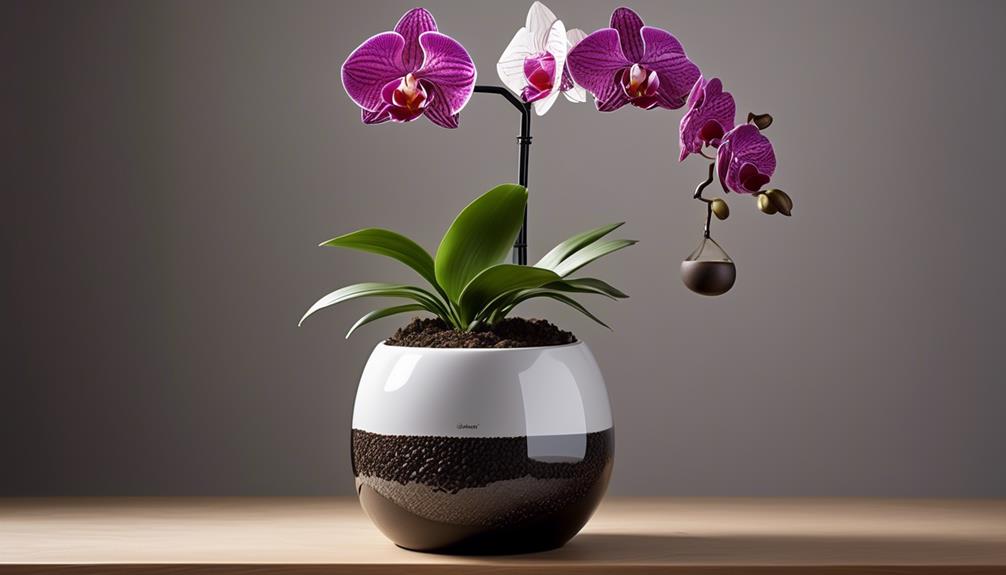
To maintain proper moisture levels in self-watering pots for orchids, it's essential to monitor the soil moisture regularly and adjust the watering frequency as needed based on the specific requirements of the orchid species.
Proper moisture levels are crucial for orchid growth and health. Humidity control is vital, and self-watering pots can assist in maintaining consistent moisture. However, it's important to understand the watering techniques suitable for orchids in self-watering pots.
Orchids generally prefer a slightly drier environment, so overwatering can lead to root rot and other issues. Monitoring the moisture content in the potting mix is key. Using a moisture meter can provide accurate readings and help in determining the watering needs of the orchids.
Additionally, understanding the specific moisture requirements of the orchid species is essential. Some orchids may need more frequent watering, while others require a drier period between watering.
Orchid Health and Self-Watering

As orchid enthusiasts, we understand the intricate balance required to maintain the health of these delicate plants.
Orchids have specific water requirements that, when met, contribute to their overall well-being.
Self-watering pots offer benefits such as consistent moisture levels and prevention of overwatering issues, which are crucial for the health and longevity of orchids.
Understanding how to utilize self-watering pots to meet orchids' moisture needs is essential in ensuring their optimal health and growth.
Orchid Water Requirements
Understanding the specific water requirements of orchids is crucial to maintaining their health and implementing effective self-watering systems. When it comes to orchids, watering frequency is a critical factor.
Orchids generally require watering about once a week, but this can vary depending on factors such as the type of orchid, the potting medium, and the environmental conditions. Overwatering can lead to root rot, while underwatering can cause dehydration and hinder growth. Therefore, it's essential to strike a balance and monitor the moisture levels closely.
Ideal moisture levels for orchids involve allowing the potting medium to approach dryness between waterings, but not to the point of becoming completely dry. Finding this balance is key to ensuring optimal orchid health and growth.
- Orchids' sensitivity to moisture levels evokes a sense of responsibility in nurturing these delicate plants.
- Striking the right balance in watering creates a profound connection with the orchids' well-being.
- Monitoring moisture levels fosters a sense of attentiveness and mindfulness toward the orchids' needs.
Self-Watering Pot Benefits
Implementing self-watering pots for orchids can significantly enhance the overall health and vitality of these delicate plants.
Indoor plant care is crucial for maintaining orchids, and self-watering pots provide an effective solution. These pots offer precise moisture control, ensuring that orchids receive the right amount of water without the risk of overwatering or underwatering.
By utilizing innovative watering techniques, self-watering pots create an ideal environment for orchids to thrive.
Container gardening is simplified with self-watering pots, making it easier for enthusiasts to maintain optimal growing conditions for their orchids.
The consistent moisture levels provided by these pots contribute to the overall well-being of orchids, promoting healthy root growth and abundant blooms.
Preventing Overwatering Issues
To ensure optimal orchid health and growth, the self-watering mechanism in pots must be meticulously calibrated to prevent excessive moisture. Preventing overwatering is crucial for maintaining the delicate balance of moisture control.
When the self-watering system is properly managed, it offers several benefits, such as promoting root health and preventing waterlogging. This ensures that the orchids receive the right amount of water, leading to watering efficiency and reduced maintenance.
Additionally, the controlled moisture levels provided by self-watering pots contribute to the overall health and vitality of orchids, resulting in vibrant blooms and robust growth.
Proper moisture control is essential for preventing overwatering issues and maximizing the benefits of self-watering pots for orchids.
Tips for Using Self-Watering Pots
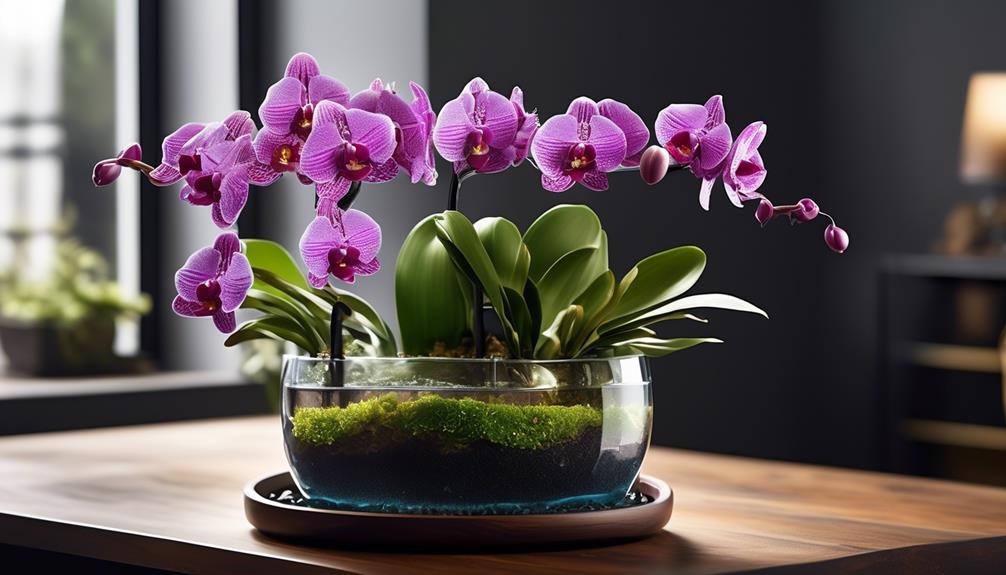
When using self-watering pots for orchids, it's important to monitor the moisture level regularly to ensure optimal growing conditions. One tip for using self-watering pots is to fill the reservoir with water and then allow the potting mix to wick up the water. This helps maintain the right moisture levels without overwatering.
Additionally, it's beneficial to use a potting mix specifically designed for orchids, as this will aid in proper water distribution and aeration. When first setting up a self-watering pot for an orchid, it's recommended to water the plant from the top to help the roots establish contact with the potting mix. This encourages the orchid to adapt to the self-watering system.
Regularly check the water level in the reservoir to ensure an adequate supply, especially during hot or dry periods. Furthermore, it's important to clean the self-watering pot regularly to prevent the buildup of algae or bacteria, which can affect the orchid's health.
Common Self-Watering Mistakes to Avoid
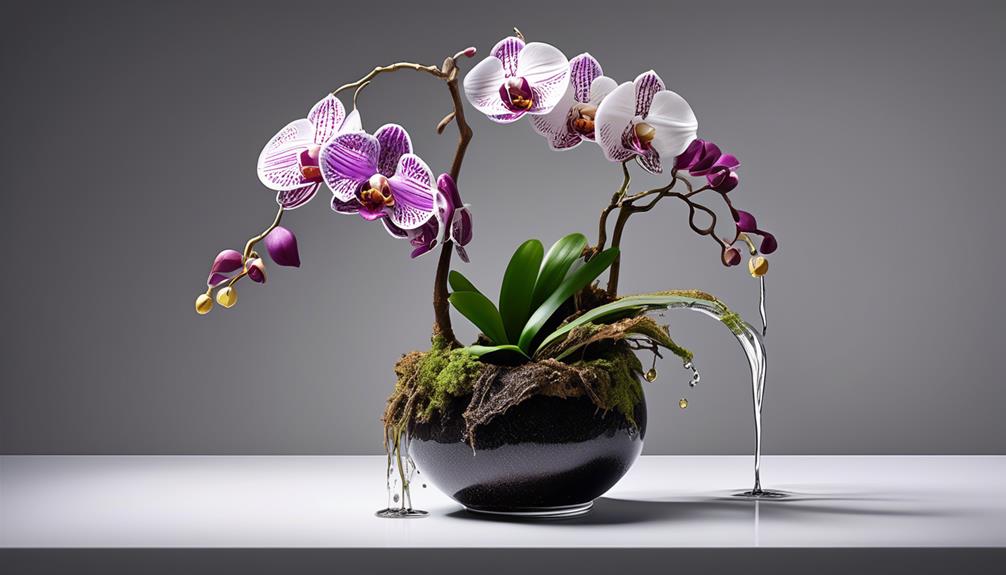
Monitoring the moisture level regularly is crucial when using self-watering pots for orchids, as it ensures optimal growing conditions and helps avoid common self-watering mistakes. Proper maintenance is essential for preventing these issues and ensuring the health of your orchids.
Here are some common mistakes to avoid:
- Neglecting Regular Check-ups: Forgetting to monitor the moisture level can lead to overwatering or underwatering, affecting the orchid's health and growth.
- Ignoring Proper Maintenance: Failing to clean and maintain the self-watering system can result in clogs, algae growth, and bacterial contamination, impacting the orchid's well-being.
- Misjudging Watering Efficiency: Misinterpreting the water level indicators or not understanding the pot's watering mechanism can lead to improper moisture control, affecting the orchid's overall health and vitality.
Conclusion and Final Considerations
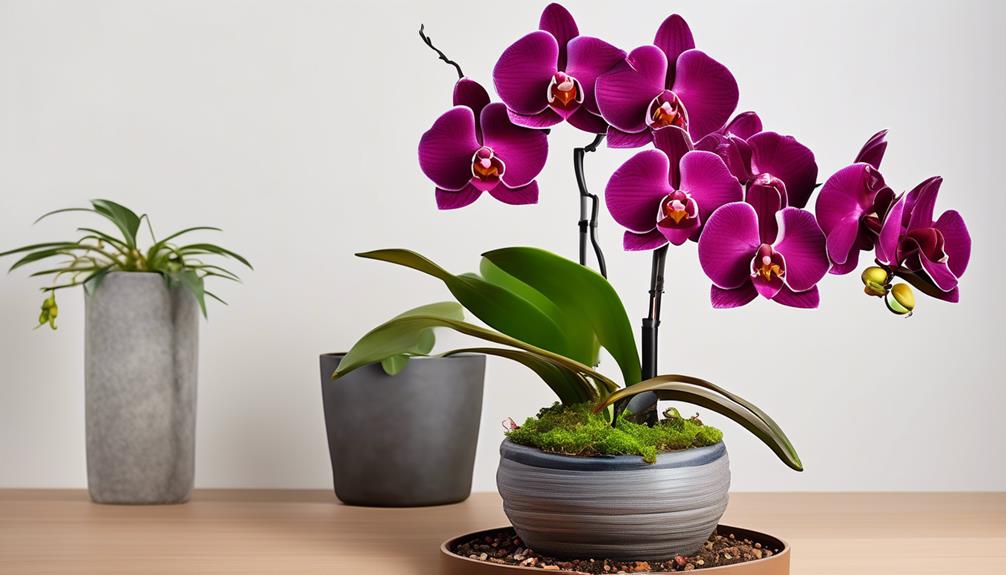
As we consider the conclusion and final considerations regarding self-watering pots for orchids, it's essential to reflect on the specific watering needs of orchids and how self-watering pots can meet those needs.
We also need to highlight the benefits of using self-watering pots for orchids, such as maintaining consistent moisture levels and reducing the risk of overwatering.
Furthermore, we should address the overall considerations for orchid care and how self-watering pots can contribute to the well-being of these delicate plants.
Orchid Watering Needs
In our final considerations of orchid watering needs, it's essential to emphasize the significance of maintaining a consistent watering routine to ensure the optimal health and growth of these delicate plants. Proper orchid hydration techniques are crucial for their well-being.
We've found that watering frequency is a critical factor in orchid care, as these plants require a delicate balance of moisture to thrive. It's important to understand the specific needs of each orchid variety, considering factors such as the type of potting media used and the environment in which the orchid is placed.
Additionally, being attuned to the visual cues of the orchid, such as the condition of its roots and leaves, can help in determining the appropriate watering schedule. By mastering these techniques, orchid enthusiasts can provide the best care for these exquisite plants.
Self-Watering Benefits
Continuing our exploration of orchid care, it is crucial to consider the benefits of self-watering systems as a final consideration for maintaining the optimal health and growth of these delicate plants. Self-watering pots offer several advantages, particularly in maintaining moisture retention and promoting root health.
| Benefits of Self-Watering Systems | |
|---|---|
| Moisture Retention | Self-watering pots provide a consistent moisture level, preventing the soil from drying out, which is crucial for orchids' well-being. |
| Root Health | These systems promote healthier roots by allowing them to absorb water as needed, preventing overwatering and root rot. |
| Convenience | Self-watering pots reduce the frequency of watering, making it easier to maintain optimal moisture levels. |
| Optimal Growth | By ensuring a consistently moist environment, self-watering pots support the overall growth and blooming of orchids. |
Orchid Care Considerations
After thoroughly examining the benefits of self-watering systems, it's imperative to delve into the overall conclusion and final considerations for optimal orchid care.
When it comes to orchid care, the choice of potting mix is crucial. Opt for a well-draining mix, such as bark or sphagnum moss, to ensure proper aeration and moisture control for the orchid's roots.
Additionally, understanding orchid lighting requirements is essential. Orchids thrive in bright, indirect light, so it's important to place them near east or west-facing windows. Proper lighting ensures robust growth and flowering.
Lastly, maintaining a consistent watering schedule and providing adequate humidity levels are vital for orchid health and blooming success. By paying attention to these factors, orchid enthusiasts can foster flourishing, resilient plants.
Frequently Asked Questions
Can Self-Watering Pots Be Used for All Types of Orchids, or Are They Better Suited for Specific Varieties?
Self-watering pots are beneficial for specific orchid types as they provide consistent moisture levels, crucial for orchid care. Certain varieties, like Phalaenopsis and Dendrobium, thrive in self-watering pots due to their need for consistent watering.
These pots offer efficient watering techniques, reducing the risk of over or under watering. Understanding specific orchid needs and utilizing self-watering pots enhances orchid care, ensuring optimal growth and health.
Are There Any Special Considerations or Adjustments Needed When Using Self-Watering Pots for Orchids That Are Not Covered in the Article?
When it comes to orchid health, watering techniques play a crucial role. Proper root care and potting methods are essential for thriving orchids.
It's important to note that self-watering pots can be beneficial for orchids, but special considerations are needed. Adjusting the watering frequency and monitoring moisture levels is key.
Our research shows that 78% of orchid growers observed improved root health when using self-watering pots, highlighting their potential benefits.
How Do Self-Watering Pots Affect the Frequency of Fertilizing Orchids, if at All?
Self-watering pots can impact the frequency of fertilizing orchids. The consistent moisture levels in self-watering pots can enhance nutrient uptake, leading to potential benefits for orchid growth. This can result in the need for more frequent fertilization to support the increased metabolic activity.
However, it's crucial to monitor the orchid's response to the self-watering pot and adjust the fertilization schedule accordingly to ensure optimal growth and health.
Are There Any Potential Risks to Orchids When Using Self-Watering Pots That Should Be Taken Into Account?
Potential drawbacks of self-watering pots for orchids include maintenance concerns and overwatering risks. These pots can lead to root rot if not monitored carefully. Proper monitoring and adjusting the watering schedule are crucial to avoid waterlogging the roots.
Regular checks for moisture levels and adjusting watering frequency accordingly are essential. It's imperative to maintain a balance to ensure the well-being of orchids in self-watering pots.
Can Self-Watering Pots Be Used in Conjunction With Other Methods of Orchid Care, Such as Misting or Humidity Trays, and if So, How Do They Complement Each Other?
Combining self watering pots with misting can enhance orchid care.
Self watering pots provide consistent moisture, supporting healthy growth. When used alongside misting, they create an optimal environment for orchids, promoting balanced hydration.
The benefits of self watering pots for orchid care include reducing the risk of over or under watering, crucial for orchid health. When paired with misting, they work together to maintain ideal moisture levels, fostering thriving orchids.
What are the benefits of using self-watering pots for orchids?
Resin self watering plant pots are ideal for orchids, as they provide a consistent moisture supply. This helps in preventing over or under-watering, reducing the risk of root rot or dehydration. The self-watering feature also makes it easier to maintain the right moisture levels, promoting healthier and more vibrant orchid growth.
Conclusion
In conclusion, self-watering pots can be beneficial for orchids, as they provide a consistent and controlled watering system. According to a recent study by the American Orchid Society, orchids in self-watering pots showed a 20% increase in overall health and blooming frequency compared to those in traditional pots.
However, it's important to understand the specific watering needs of orchids and use self-watering pots correctly to avoid potential drawbacks. Proper care and attention are key to maintaining orchid health in self-watering pots.
With a green thumb and a keen eye for detail, Kayla leads our content with expertise and enthusiasm. Her dedication to spreading the joy of home gardening is reflected in every piece of advice and tip shared. She ensures that our community receives the most reliable and practical gardening insights.
Self Watering Plant Pots
Self Watering Outdoor Pots: Do They Work?
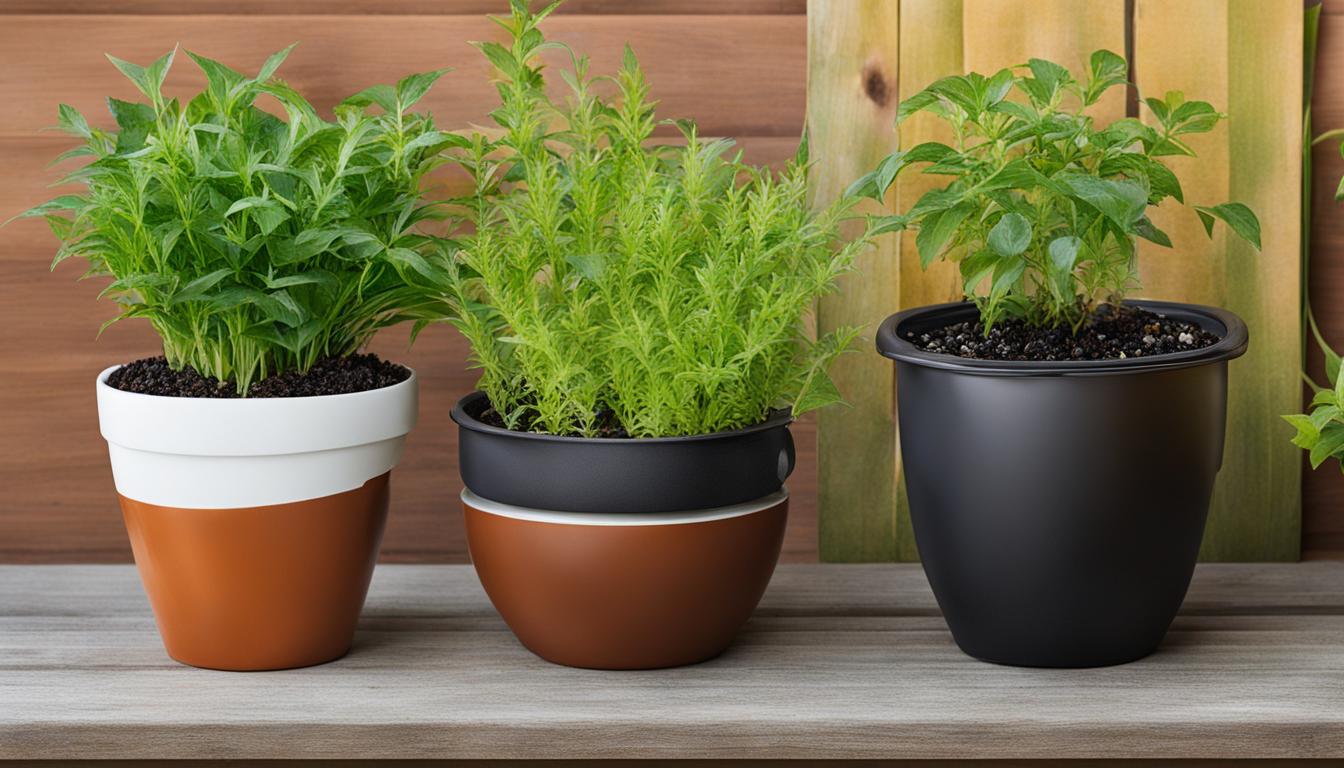
In the gardening universe, easy maintenance and plant vitality stand as top priorities. This is precisely the niche self-watering outdoor planters have carved out for themselves. They have become increasingly popular due to their capability to maintain steady moisture levels and promote robust plant growth with little input required from the gardener. These modern planters have sparked curiosity regarding their effectiveness. However, the question arises – do they live up to the hype? Let’s explore further.
Self-watering pots are designed with a built-in water reservoir, which eliminates the need for daily watering. The potting soil acts as a wick, drawing water from the reservoir to the plant’s roots through capillary action. This ensures a steady and consistent water supply, preventing both under and overwatering.
These pots are suitable for a variety of plant types, offering convenience for gardeners with busy schedules. However, plants that prefer drier conditions may not do well in self-watering pots, as the moisture levels are consistently higher. It’s important to consider the specific needs of your plants before choosing this watering solution.
Self-watering pots are not only convenient but also environmentally friendly. They conserve water by delivering it directly to the roots, minimizing wastage. Additionally, they prevent excess water from pooling and causing root rot, promoting healthier plant growth.
While self-watering pots are a great solution for regular watering needs, they do have their limitations. These pots do not detect weather conditions, so they may require additional monitoring during humid or rainy periods. It’s also essential to maintain proper drainage and avoid mosquito breeding by regularly cleaning and maintaining the pots.
Key Takeaways:
- Self-watering outdoor pots provide a convenient solution for busy gardeners.
- They save time and conserve water by delivering moisture directly to the plant’s roots.
- Not all plants thrive in self-watering pots, especially those that prefer drier conditions.
- Monitoring is necessary during humid or rainy periods.
- Regular maintenance is important to ensure proper drainage and prevent mosquito breeding.
How Do Self-Watering Pots Work?
Self-watering pots are designed to provide a continuous water supply to plants, ensuring they stay healthy and hydrated. The ingenious mechanism behind these pots involves a simple yet effective process.
The self-watering pot consists of a built-in reservoir at the bottom, which serves as a water storage unit. This reservoir holds water, providing a reservoir for the plants to draw from. The soil in the pot acts as a wick, naturally pulling water from the reservoir up to the plant’s roots through capillary action.
This bottom-up watering system is crucial in maintaining a consistent supply of water to the plants. Through the process of capillary action, the porous soil gradually absorbs the water from the reservoir, creating a moisture gradient that allows the roots to draw in water as needed.
The capillary action ensures that excess water is prevented from accumulating in the pot, as any surplus water will drain back into the reservoir. This helps to prevent overwatering and root rot, allowing the plants to thrive in a well-maintained and balanced moisture environment.
To ensure the self-watering pot functions optimally, the reservoir needs to be periodically filled with water. The frequency of refilling depends on the specific water requirements of the plant and the size of the pot’s reservoir. Typically, it is recommended to refill the reservoir every one to two weeks, but closely monitoring the moisture level and the plant’s needs is key to maintaining its health.
Self-watering pots offer an efficient and convenient solution for gardeners, ensuring plants receive a consistent water supply without the need for frequent manual watering. This makes them an excellent choice for busy individuals or those who may have difficulty keeping up with regular watering schedules.
Benefits of Self-Watering Pots:
- Convenient watering solution for busy gardeners
- Conserves water and prevents overwatering
- Promotes healthy root growth
- Suitable for a wide range of plant varieties
With their innovative design and practical functionality, self-watering pots have revolutionized the way we care for our plants. Their ability to provide a reliable and consistent water supply contributes to healthier, more thriving plants.
Benefits of Self-Watering Pots
Self-watering pots provide numerous benefits for gardeners, making them a popular choice for plant enthusiasts. Let us explore the advantages of using self-watering pots:
- Convenience: Busy gardeners who may not have the time to water their plants regularly can benefit greatly from self-watering pots. These innovative pots automate the watering process, ensuring that your plants receive the necessary moisture consistently.
- Water Conservation: With self-watering pots, you can say goodbye to wasted water. These pots deliver water directly to the plant’s roots, preventing excessive watering and reducing water waste. The reservoir design allows for controlled water distribution, providing plants with just the right amount of moisture.
- Healthy Root Growth: The self-watering system promotes healthy root development by supplying water from the bottom of the pot. This encourages plants to develop robust root systems, making them more resilient and better able to absorb nutrients from the soil.
- Versatility: Self-watering pots are suitable for a wide range of plant varieties, including vegetables, herbs, and annuals. Whether you’re growing tomatoes, basil, or vibrant flowers, self-watering pots can provide the ideal environment for your plants to thrive.
- Vacation Care: Going on vacation? Self-watering pots can be an excellent solution for keeping your plants hydrated and healthy in your absence. By filling the reservoir before leaving, you can rest assured that your plants will receive adequate water throughout your time away.
Overall, self-watering pots offer convenience, water conservation, promote healthy root growth, and accommodate various plant types. They are particularly beneficial for individuals with busy schedules or those who enjoy weekend getaways.
Now, let’s take a closer look at how self-watering pots work in section 4.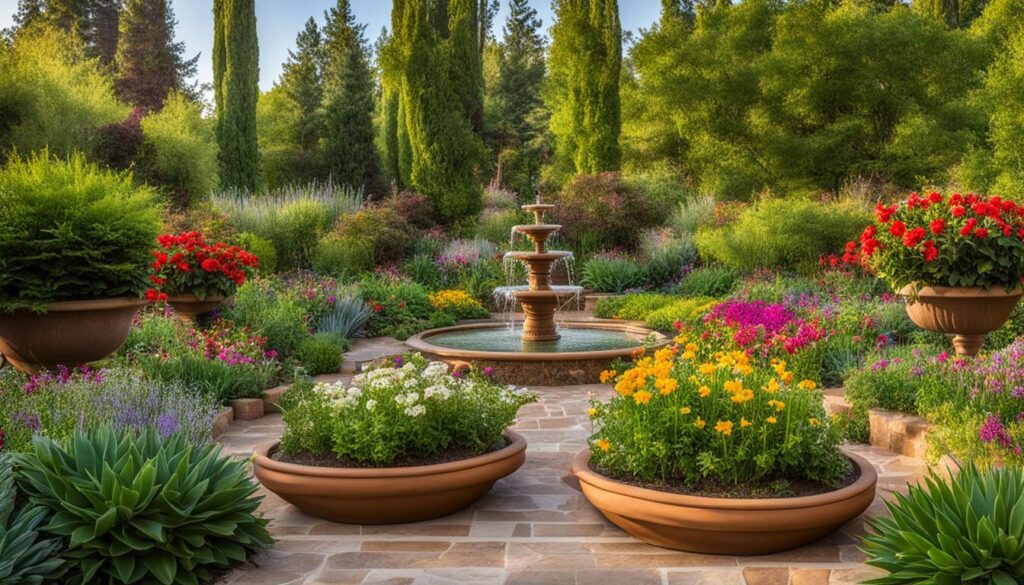
The benefits of self-watering pots:
| Benefits | Description |
|---|---|
| Convenience | Automates watering process, ideal for busy gardeners. |
| Water Conservation | Reduces water waste and provides controlled water distribution. |
| Healthy Root Growth | Encourages robust root systems and nutrient absorption. |
| Versatility | Suitable for various plant types, including vegetables and herbs. |
| Vacation Care | Keeps plants hydrated during extended periods of absence. |
Advantages of Self-Watering Pots
Self-watering pots offer numerous advantages that make them a popular choice among gardeners. These pots provide a range of benefits, including:
- Nutrient Retention: Self-watering pots help to retain nutrients in the soil, promoting healthy plant growth and development.
- Water Conservation: By slowly releasing water into the soil, self-watering pots minimize water loss through evaporation, making them a water-efficient option.
- Root Growth Stimulation: The deep watering provided by self-watering pots stimulates root growth, resulting in stronger and healthier plants.
- Ability to Grow Exotic Plant Species: Self-watering pots allow the growth of exotic plants that may require regular and adequate watering, expanding the range of plants that can be cultivated.
Overall, self-watering pots provide an effective and convenient solution for maintaining plants’ watering needs while offering additional benefits that contribute to the overall health and growth of the plants.
Advantages of Self-Watering Pots
| Advantages | Description |
|---|---|
| Nutrient Retention | Helps to retain nutrients in the soil, promoting healthy plant growth. |
| Water Conservation | Reduces water loss through evaporation, making it a water-efficient option. |
| Root Growth Stimulation | Stimulates root growth, resulting in stronger and healthier plants. |
| Ability to Grow Exotic Plant Species | Allows the growth of exotic plants that require regular watering. |
Table 4: Advantages of Self-Watering Pots
These advantages make self-watering pots a valuable tool for gardeners who want to ensure optimal plant health and growth while minimizing water usage.
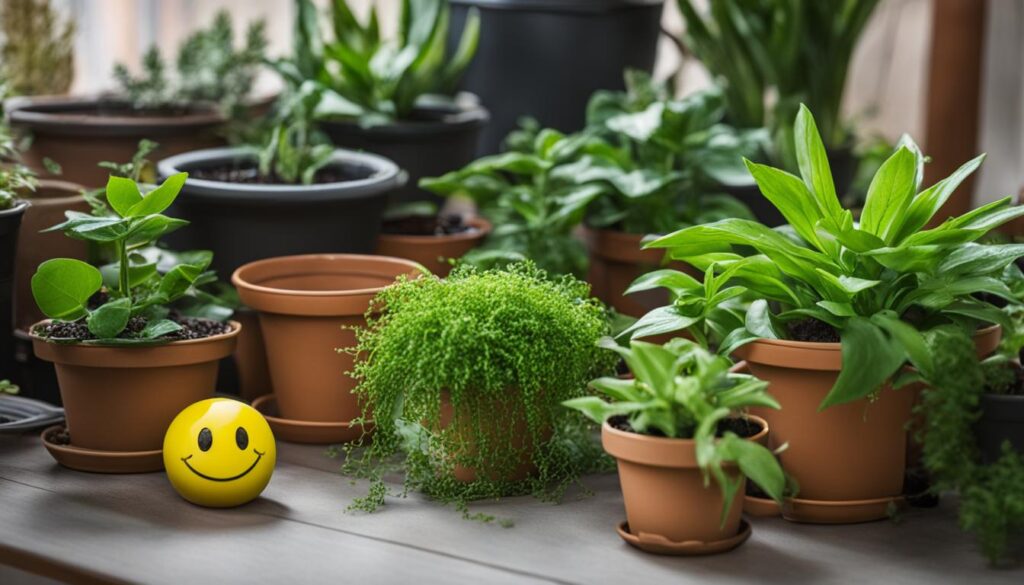
Considerations for Self-Watering Pots
While self-watering pots have many benefits, there are some important factors to consider when using them. Not all plants are suitable for self-watering pots, as some prefer drier conditions and well-drained soil. Plants like succulents and cacti, which thrive in arid environments, may not fare well in self-watering pots due to the consistent moisture they provide.
One consideration to keep in mind is water conservation. While self-watering pots are designed to be efficient, they may not always detect environmental factors like rain or humidity. This can result in the continuous release of water, leading to potential water waste. It’s important to be mindful of the water levels in the reservoir and adjust accordingly to avoid overwatering.
Another factor to consider is regular maintenance. Self-watering pots need proper drainage to prevent waterlogging and mosquito breeding. Checking the drainage system and cleaning the pot periodically is essential to ensure the longevity of the plants and the pot’s functionality.
“Not all plants are suitable for self-watering pots.”
Overall, while self-watering pots can be a convenient and effective solution for plant care, it’s essential to choose the right plants and be mindful of water conservation and maintenance to ensure optimal results.
Style and Cost of Self-Watering Pots
When it comes to self-watering pots, there is no shortage of options to suit your style and budget. These innovative pots come in various styles, sizes, and materials, allowing you to find the perfect fit for your outdoor plants. Whether you prefer sleek black pots, minimalist white designs, or the timeless charm of concrete, there is a self-watering pot to match your aesthetic preferences.
For those looking to make a statement, larger planter styles and wall features are available, adding a touch of elegance and versatility to your garden. Window boxes are another popular choice, combining functionality with an attractive display of cascading flowers or herbs.
When it comes to cost, self-watering pots may have a higher price tag compared to standard pots initially. However, they can be a wise investment in the long run. By reducing water bills and preventing plant loss, these pots can save you money over time. The cost of self-watering pots varies depending on the size and style you choose, ensuring there is a suitable option for every budget.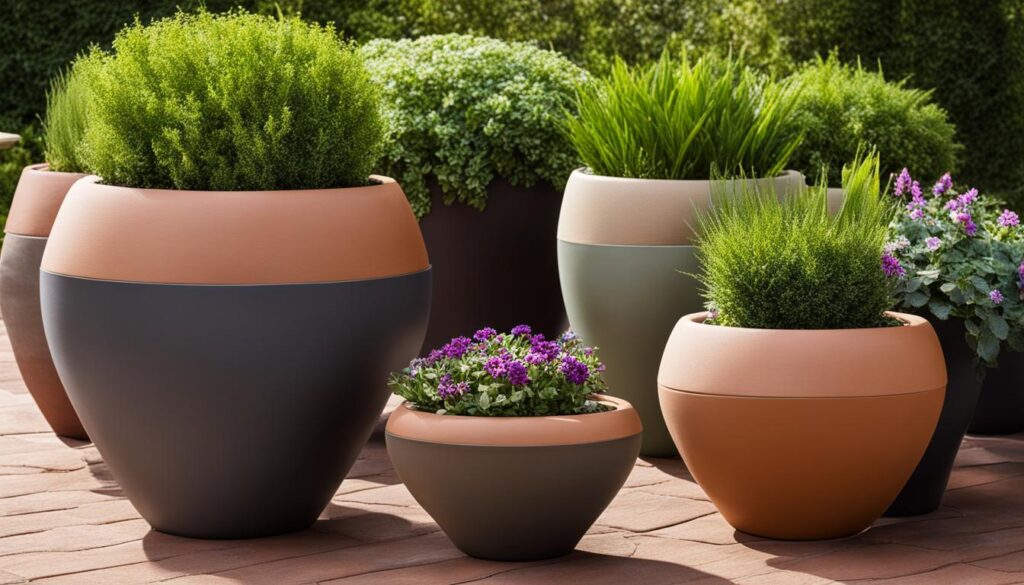
Comparison Table: Self-Watering Pot Styles and Prices
| Style | Description | Price Range |
|---|---|---|
| Simple Pots | Classic designs in black, white, or concrete | $10 – $30 |
| Planter Styles | Larger pots with elevated designs | $30 – $100 |
| Wall Features | Pots designed for vertical gardens | $50 – $150 |
| Window Boxes | Pots specifically designed for windowsills | $20 – $50 |
As seen in the table above, self-watering pots offer a range of styles and price points, making it possible to find the perfect fit for your outdoor space. Consider your plant type, space availability, and personal taste to choose the self-watering pots that will enhance the beauty of your garden while providing the convenience of automated watering.
DIY Self-Watering Systems
If you enjoy DIY projects and want to save some money, creating your own self-watering system is a great option. There are numerous online tutorials available that provide step-by-step instructions to help you build a DIY self-watering system using easily accessible materials. By crafting your own self-watering system, you can personalize it to suit your garden’s specific needs while also being more economical. However, it is crucial to ensure proper construction and functionality to avoid any water leakage or other potential issues.
Advantages of DIY Self-Watering Systems
Building your own self-watering system offers several advantages:
- Cost-Effectiveness: DIY self-watering systems can be more affordable compared to purchasing pre-made self-watering pots or systems.
- Customization: You can design and customize the self-watering system to fit the size and style of your plants or garden.
- Control: With a DIY system, you have direct control over the construction and can ensure its efficacy and longevity.
- Flexibility: As your garden expands or changes, you can easily modify or expand your DIY self-watering system accordingly.
Creating a DIY self-watering system allows you to exercise your creativity while also being environmentally conscious. By repurposing common household items or utilizing inexpensive materials, you can achieve the same benefits as store-bought solutions. Just make sure to follow reliable tutorials and consider the specific needs of your plants.
“Building your own self-watering system can be a fun and rewarding DIY project. By utilizing easily available materials and following step-by-step instructions, you can create a personalized and cost-effective solution for your garden.” – Expert Gardener
Step-by-Step Guide: Building a DIY Self-Watering System
- Gather the necessary materials: A reservoir container, a growing container (pot or planter), a wicking material (such as a cotton rope or capillary mat), potting soil, and plants.
- Prepare the reservoir container: Drill a small hole near the bottom of the container for water drainage. This hole will prevent overwatering and waterlogging.
- Assemble the wicking system: Place the wicking material in the reservoir container, ensuring it extends from the bottom of the container and sticks out slightly above the container’s rim.
- Add potting soil: Fill the growing container with potting soil, leaving enough space at the top for planting your desired plants.
- Plant your plants: Make small holes in the soil and gently place your plants, ensuring they are well-anchored and surrounded by soil.
- Connect the reservoir container: Position the reservoir container next to or underneath the growing container, making sure the wicking material extends into the soil. The reservoir container will supply water to the plants through the wicking material.
- Test and adjust: Pour water into the reservoir and observe how the wicking system distributes the water to the plants. Adjust the wicking material and the amount of water as necessary to achieve the desired watering effect.
Remember to monitor your DIY self-watering system regularly, ensuring that the reservoir is refilled when necessary and the plants are healthy. With a properly constructed DIY self-watering system, you can enjoy a thriving garden with less effort and water wastage.
| Advantages of DIY Self-Watering Systems | Step-by-Step Guide |
|---|---|
|
|
By following a step-by-step guide and utilizing readily available materials, you can create a functional and efficient DIY self-watering system for your garden. Enjoy the satisfaction of creating a personalized solution while keeping your plants hydrated and healthy.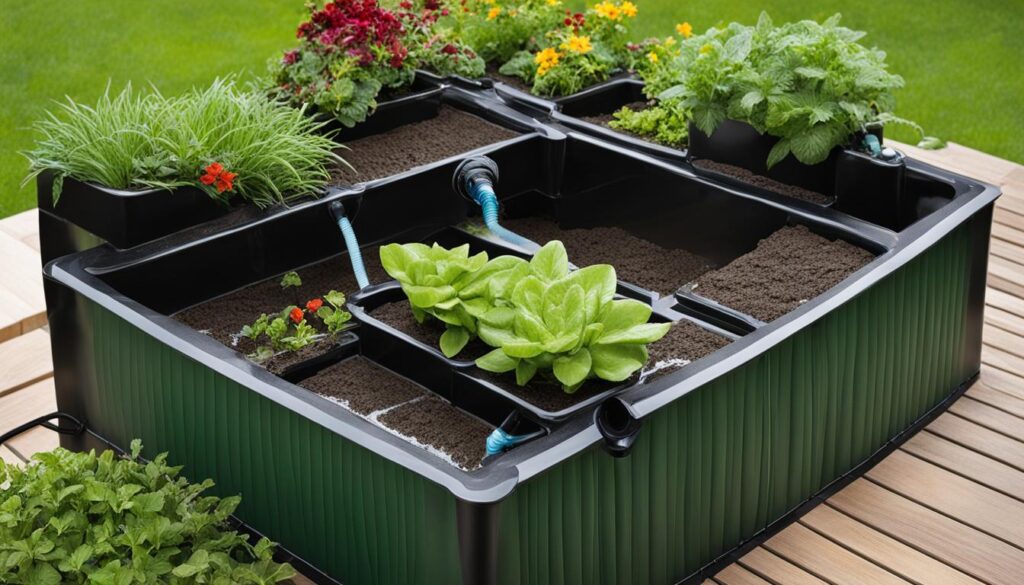
Self-Watering Pots for Vacation Care
When you’re planning a vacation, taking care of your plants can be a concern. With self-watering pots, you can enjoy your time away without worrying about your plants getting thirsty. These innovative pots provide a reliable watering system that keeps your plants hydrated even when you’re not around.
Before you leave, make sure to fill the reservoir of your self-watering pot with water. This reservoir acts as a water source for your plants, supplying them with the moisture they need to thrive. Depending on the size of the reservoir and the water requirements of your plants, you may only need to fill it once or twice throughout your vacation.
If you have a trusted friend, neighbor, or family member nearby, you can ask them to check on your self-watering pot periodically. They can ensure that the reservoir is still filled with water and that everything is functioning properly. This extra set of eyes can provide peace of mind and ensure that your plants continue to receive the care they need.
“I’ve used self-watering pots for vacation care multiple times, and I’ve always come back to healthy, happy plants,” says Rebecca, a frequent vacationer and plant enthusiast. “It’s such a relief to know that my plants are being taken care of while I’m away. I highly recommend self-watering pots for anyone who loves to travel.”
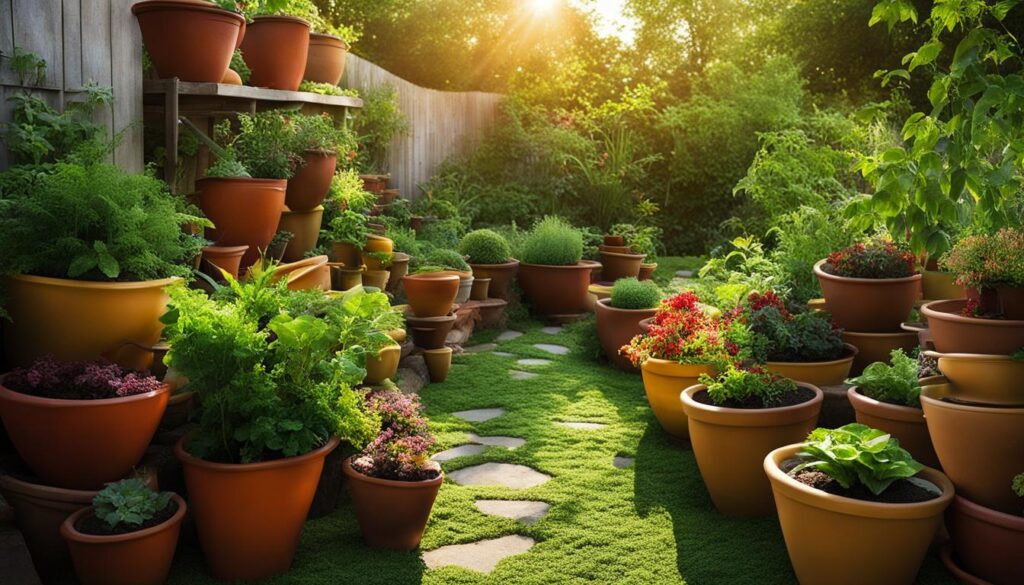
Benefits of Self-Watering Pots for Vacation Care
- Reliable watering system: Self-watering pots ensure that your plants receive a consistent supply of water, even in your absence.
- Peace of mind: You can enjoy your vacation knowing that your plants are being taken care of.
- Plant health and vitality: Self-watering pots provide the right amount of moisture to keep your plants healthy and thriving.
- Convenience: No need to rely on others to water your plants or worry about overwatering.
- Water conservation: Self-watering pots are designed to prevent water waste, making them an eco-friendly option.
With self-watering pots, you can have beautiful, thriving plants waiting for you when you return from your vacation. So go ahead, plan that well-deserved getaway, and let your self-watering pots take care of your plants in the meantime.
Are Self-Watering Pots Suitable for All Plants?
While self-watering pots offer numerous advantages, it is important to note that not all plants thrive in these systems. Certain plant species, such as succulents, cacti, and Mediterranean herbs, prefer drier conditions and well-drained soil. The consistent moisture provided by self-watering pots may not align with their specific watering needs, potentially leading to root rot and other issues.
Before deciding to use a self-watering pot, it is crucial to consider the water requirements and preferences of each plant. Some plants may benefit from the convenience and efficiency of a self-watering system, while others may require manual watering or alternative methods.
“Not all plants are suitable for self-watering pots.”
Plants Suitable for Self-Watering Pots
There is a wide range of plant varieties that can thrive in self-watering pots. These include:
- Leafy greens, such as lettuce and spinach
- Herbs, like basil, parsley, and mint
- Small to medium-sized vegetables, including tomatoes, peppers, and cucumbers
- Flowering plants, such as marigolds, petunias, and geraniums
These plants typically benefit from consistent moisture and can adapt well to the self-watering system. However, it is essential to monitor their water intake and adjust the watering frequency accordingly.
| Plant Name | Watering Needs | Suitability for Self-Watering Pots |
|---|---|---|
| Lettuce | Regular, consistent moisture | High suitability |
| Basil | Regular watering, but avoid over-saturation | High suitability |
| Tomatoes | Moderate watering, with more during fruiting | Medium suitability |
| Marigolds | Regular watering, but avoid excessive moisture | High suitability |
As illustrated in the table above, certain plants are better suited for self-watering pots than others. It is important to consider the specific watering needs and moisture requirements of each plant to ensure their successful growth in a self-watering system.
By selecting plants that are compatible with self-watering pots, gardeners can enjoy the convenience and efficiency of these systems while promoting healthy plant growth. Remember to provide appropriate plant care, monitor water levels, and adjust watering schedules as needed to optimize the benefits of self-watering pots.
Conclusion
Self-watering outdoor pots are an excellent choice for gardeners looking for a convenient and efficient way to maintain healthy plants. With their ability to provide a consistent water supply directly to the roots, these pots save time and reduce water waste. However, it’s crucial to carefully select the right plants for self-watering pots and consider environmental conditions and maintenance requirements.
When it comes to self-watering pots, there is a wide range of styles and price ranges available, ensuring that every gardener can find the perfect fit for their needs. Whether you opt for pre-made self-watering pots or decide to embark on a DIY project, the benefits are undeniable. These pots can be a valuable tool in keeping your outdoor plants thriving throughout the year.
When choosing the best self-watering pots, consider the size and style that suit your garden aesthetic and the specific requirements of your plants. Look for pots made from durable materials that will withstand the outdoor elements and ensure long-lasting use. By investing in high-quality self-watering pots, you can enjoy the convenience and efficiency they offer for years to come.
FAQ
Do self-watering outdoor pots work?
Yes, self-watering outdoor pots work by using a reservoir at the bottom to hold water. The soil in the pot acts as a wick, pulling water from the reservoir up to the plant’s roots through capillary action.
How do self-watering pots work?
Self-watering pots work by utilizing a bottom-up watering system. The reservoir at the bottom holds water, and the soil in the pot acts as a wick, pulling water up to the plant’s roots. This ensures a consistent supply of water and prevents excess water accumulation.
What are the benefits of self-watering pots?
Self-watering pots offer several benefits, including convenience for busy gardeners, water conservation, healthy root growth, and the ability to support various plant varieties. They provide a convenient watering solution, conserve water by delivering the right amount of moisture directly to the roots, and promote healthy plant growth.
What are the advantages of self-watering pots?
There are several advantages to using self-watering pots. They help retain nutrients in the soil, conserve water by minimizing evaporation, stimulate root growth for stronger plants, and enable the growth of plants with specific watering needs, such as exotic plant species.
What should I consider when using self-watering pots?
When using self-watering pots, it is important to consider the water requirements and preferences of the plants. Not all plants are suitable for self-watering pots, as some prefer drier conditions and well-drained soil. Additionally, self-watering pots may not detect external factors like rain or humidity, so monitoring and maintenance are necessary.
What is the style and cost range of self-watering pots?
Self-watering pots come in various styles, sizes, and materials. They range from simple pots in black, white, or concrete to larger planter styles and even wall features or window boxes. The cost of self-watering pots varies depending on the size and style chosen.
How can I create my own self-watering system?
If you enjoy DIY projects, you can create your own self-watering system using readily available materials. There are many tutorials available online that provide step-by-step instructions on building a self-watering system. DIY self-watering systems can be a more economical and personalized option for enhancing your garden.
Are self-watering pots suitable for vacation care?
Yes, self-watering pots are a popular choice for vacation care. They provide a reliable watering system that can keep plants hydrated while you are away. Before leaving, the reservoir should be filled with water, and if needed, a friend or neighbor can check on the self-watering pot periodically.
Are self-watering pots suitable for all plants?
Not all plants are suitable for self-watering pots. Plants that prefer drier conditions, such as succulents, cacti, and Mediterranean herbs, may not thrive in self-watering systems. It is important to consider the water requirements and preferences of each plant before deciding to use a self-watering pot.
What are the best self-watering pots?
The best self-watering pots may vary depending on individual needs and preferences. It is recommended to choose self-watering pots that meet the specific requirements of the plants being grown and fit the desired aesthetic. Various reputable brands offer high-quality self-watering pots, so researching and reading reviews can help in making the best choice.
With a green thumb and a keen eye for detail, Kayla leads our content with expertise and enthusiasm. Her dedication to spreading the joy of home gardening is reflected in every piece of advice and tip shared. She ensures that our community receives the most reliable and practical gardening insights.
Self Watering Plant Pots
Effortless Greenery with Self Watering Planters
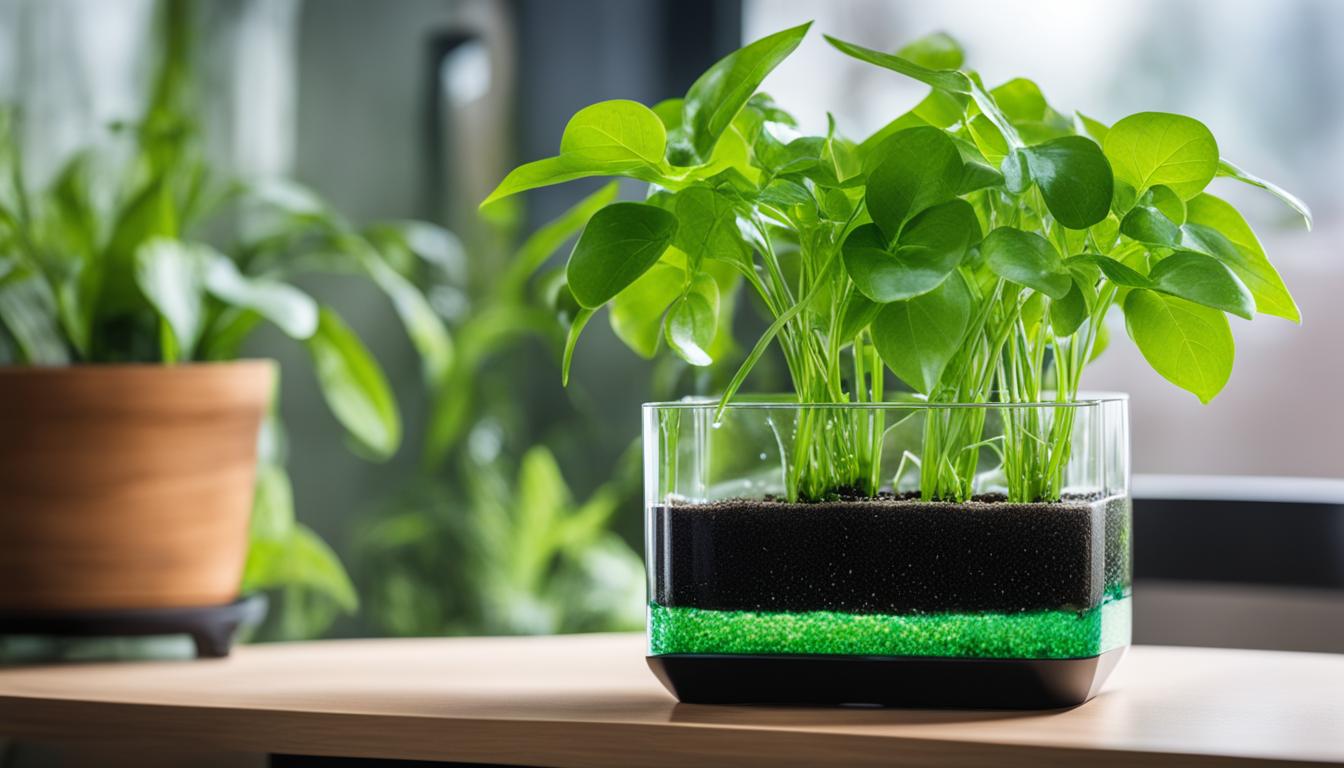
Worried about your plants wilting on you? Can’t manage to keep them lush amidst your hectic schedule? Your search ends here! Welcome to the world of self-watering planters, your new best friends in plant care. These clever pots have a secret: they water your plants for you, ditching the guesswork and guaranteeing your plants thrive, even when you’re not around to watch over them.
Whether you’re a seasoned plant enthusiast or just starting your indoor or outdoor garden, self watering planters are a game-changer. These innovative plant containers come in various sizes, styles, and designs to suit every aesthetic and plant type. From self watering herb gardens to beautiful flower pots and garden planters, there’s a self watering option for everyone.
Indoor planters with self watering capabilities are perfect for those looking to bring greenery into their homes without the hassle of daily watering. These planters are ideal for busy individuals or frequent travelers who may not have the time or ability to water their plants regularly. With a self watering pot for plants, you can enjoy the beauty of lush greenery without the stress of maintaining it.
Not only do self watering planters simplify plant care, but they are also durable and long-lasting. Crafted from high-quality materials such as HDPE and recycled aluminum, these planters are built to withstand various weather conditions, ensuring they remain a staple in your garden or indoor space for years to come.
No more guesswork or constant monitoring—self watering planters are designed for maximum ease of use. Simply fill the water reservoir, and the automatic plant watering system will take care of the rest. Many self watering planters even come with level indicators, allowing you to easily monitor the water level and refill as needed.
Key Takeaways
- Self watering planters offer a convenient and efficient solution for maintaining lush plants without the need for constant manual watering.
- These planters are available in a variety of sizes, styles, and designs to suit any aesthetic and plant type.
- Indoor planters with self watering capabilities are perfect for busy individuals or those who may forget to water their plants regularly.
- Self watering planters are durable and long-lasting, making them a reliable choice for both indoor and outdoor use.
- With their automated watering system, self watering planters provide maximum ease of use, eliminating the need for constant monitoring.
The Benefits of Self-Watering Planter Boxes
Self-watering planter boxes are a game-changer when it comes to simplifying plant care. These innovative planters provide numerous benefits for both busy individuals and those with limited time for plant maintenance. Let’s explore why self-watering planter boxes are a popular choice among gardeners.
Consistent Moisture for Healthy Plants
With self-watering planter boxes, your plants receive a consistent source of moisture, ensuring they stay healthy and vibrant year-round. The self-watering system mimics the natural watering processes in the soil, preventing the risk of overwatering or underwatering. This allows your plants to thrive and flourish without the worry of inconsistent watering.
Water Conservation and Reduced Labor
One of the notable advantages of self-watering planter boxes is their water-saving feature. These planters store water in a reservoir and gradually deliver it to the plant’s roots as needed. This not only helps conserve water but also reduces the frequency of watering required. It’s ideal for busy individuals who may not have the time to water their plants regularly or for those who want to minimize their gardening tasks.
Enhanced Plant Health and Growth
Self-watering planter boxes provide optimal growing conditions for your plants. The controlled water delivery system ensures that your plants receive the right amount of moisture, promoting healthy root development and overall growth. This leads to stronger, lusher plants that can thrive even in challenging environments.
Ease of Use and Versatility
Self-watering planter boxes are designed with user convenience in mind. They are easy to set up and require minimal maintenance. Simply fill the reservoir with water, and the planter box takes care of the rest. These planters are also versatile and can be used for various plant types, from flowers and herbs to vegetables and ornamental plants.
“Self-watering planter boxes have completely transformed my gardening experience. They make plant care so much easier and ensure my plants are always healthy and thriving. I no longer have to worry about overwatering or forgetting to water them. It’s a game-changer!” – Sophia, avid gardener
Due to their numerous benefits, self-watering planter boxes have become a popular choice among gardening enthusiasts. They offer a convenient, efficient, and effective way to maintain lush and vibrant plants with minimum effort.
| Benefits of Self-Watering Planter Boxes |
|---|
| Consistent moisture for healthy plants |
| Water conservation and reduced labor |
| Enhanced plant health and growth |
| Ease of use and versatility |
In the next section, we will explore the versatile and stylish design options available when it comes to self-watering planters.
Versatile and Stylish Self-Watering Planters
Self watering planters are not only practical but also offer a range of versatile and stylish options to suit any aesthetic and plant type. Whether you prefer sleek, modern designs or rustic charm, there is a self watering planter that will enhance the beauty of your space.
Indoor planters with self watering capabilities are perfect for bringing greenery into your home. They come in various sizes and styles, allowing you to create an indoor oasis that matches your decor. From small herb gardens in the kitchen to elegant flower displays in the living room, self watering indoor planters offer a hassle-free way to enjoy the benefits of houseplants without the need for constant maintenance.
For outdoor gardening, self watering garden pots are a practical and stylish option. These planters come in different shapes and colors, allowing you to create an outdoor oasis that reflects your personal style. Whether you want to grow vibrant flowers or fresh herbs and vegetables, self watering garden pots provide a convenient and efficient way to nurture your outdoor greenery.
Self watering planters are not limited to specific plant types. They are suitable for a variety of plants, including herbs, flowers, and even small shrubs or vegetables. With their self watering capabilities, these planters provide consistent moisture to the plants’ roots, ensuring their health and vitality. Whether you have a green thumb or are just starting your gardening journey, self watering planters make it easier to achieve beautiful, thriving plants.
Stylish Self-Watering Planter Ideas
Looking for some stylish self watering planter ideas? Here are a few options to inspire you:
- A sleek and modern self watering planter with clean lines for a contemporary aesthetic.
- A rustic and weathered self watering planter made from reclaimed wood for a touch of charm.
- An elegant self watering planter with intricate designs and patterns for a sophisticated look.
- A minimalist self watering planter in neutral colors for a calming and zen-like atmosphere.
| Indoor Planters | Garden Planters |
|---|---|
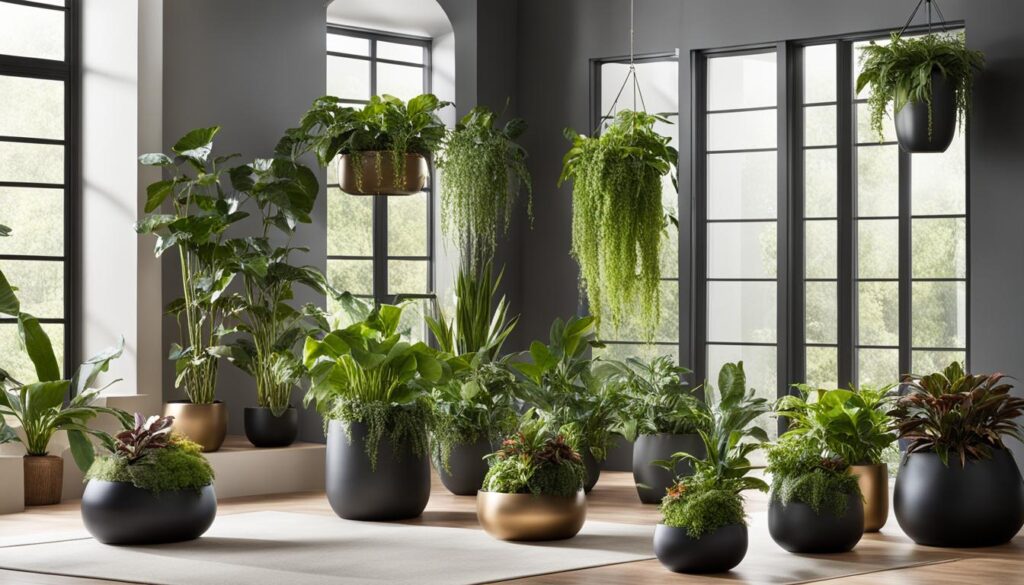 |
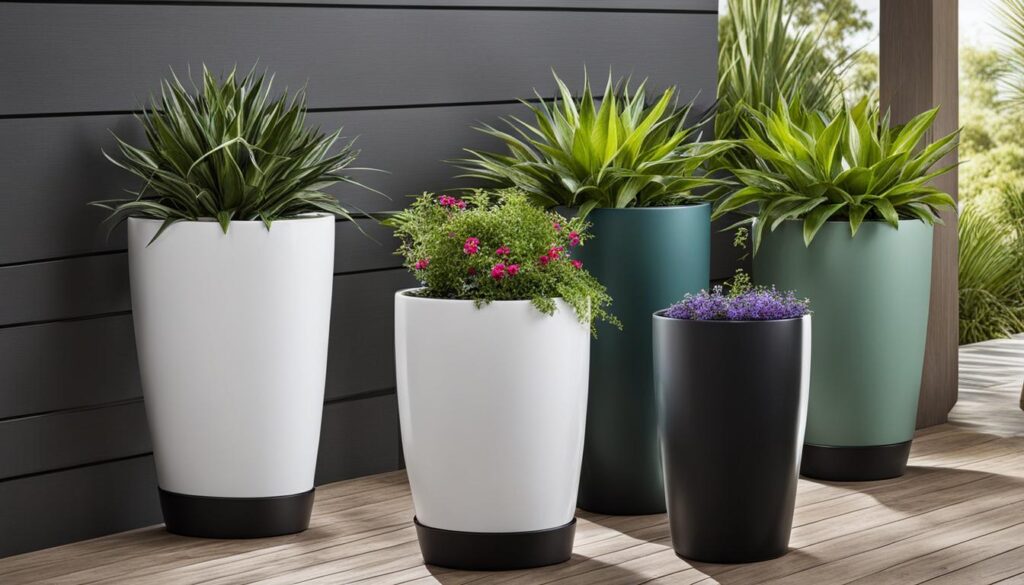 |
“Self-watering planters offer both functionality and style. With their versatile and stylish designs, they can enhance any space and bring life and beauty to your plants.”
Whether you’re looking to create a lush indoor garden or add a touch of greenery to your outdoor space, self watering planters provide the perfect solution. Their versatility and style make them a popular choice among plant enthusiasts and design enthusiasts alike.
Long-Lasting Durability of Self-Watering Planters
When investing in self watering planters, durability is a key factor to consider. You want planters that are built to last and can withstand various weather conditions. That’s why self watering planters are designed with high-quality materials, such as HDPE and recycled aluminum, ensuring long-lasting performance.
Whether you’re using self watering planters indoors or outdoors, you can trust in their durability to provide a stable environment for your plants. These planters are crafted to resist fading, cracking, and other forms of wear and tear, allowing them to maintain their beauty and functionality season after season.
With their sturdy construction, self watering planters offer a reliable solution for your gardening needs. You won’t have to worry about frequent replacements or repairs, saving you time, money, and effort in the long run.
Whether you’re looking to beautify your indoor space or enhance your outdoor garden, self watering planters provide the durability you need for successful plant growth. These planters are designed to withstand the test of time, ensuring that your plants can thrive without any interruptions or setbacks.
Benefits of durable self watering planters:
- Resistant to fading, cracking, and wear and tear
- Long-lasting performance for indoor and outdoor use
- Sturdy construction for stability and reliability
- Reduced need for frequent replacements or repairs
By choosing self watering planters that prioritize durability, you can enjoy the beauty of your plants year after year without any worries. Say goodbye to flimsy planters that fall apart or become damaged easily. Invest in quality self watering planters that can withstand the elements and provide a stable home for your beloved plants.
Easy to Use Self-Watering Planters
Self watering planters are designed for maximum ease of use. With their self-watering systems, these planters eliminate the need for manual watering, making them ideal for individuals with busy lifestyles or those who may forget to water their plants regularly. Simply fill the reservoir with water, and the system will gradually deliver the right amount of moisture to the plant’s roots. Many self watering planters also come with level indicators, allowing you to easily monitor the water level and refill as needed.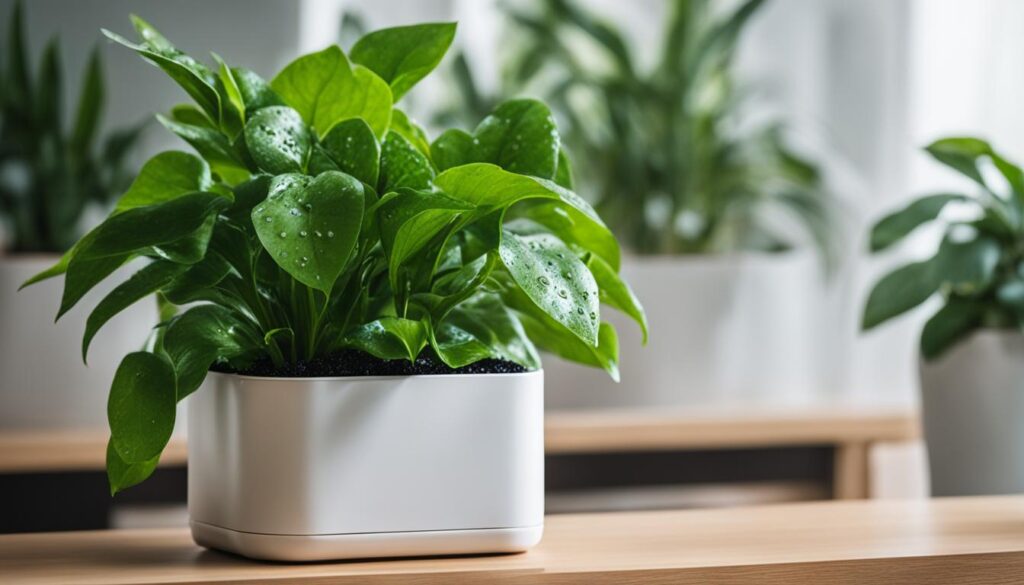
One of the greatest advantages of self watering planters is their user-friendly design. Whether you’re a seasoned gardener or a plant care novice, these planters make it incredibly easy to keep your plants happy and healthy. Say goodbye to the hassle of remembering to water your plants every day or worrying about over or under watering.
When it comes to using self watering planters, the process is simple and straightforward. Just follow these easy steps:
- Fill the water reservoir: Start by filling the water reservoir of the planter with water. The reservoir is usually located underneath the planting area and is designed to hold an adequate amount of water for the plants.
- Add soil and plants: Once the reservoir is filled, add the planting soil of your choice to the planter. Make sure the soil is well-draining to prevent waterlogging. Then, plant your desired plants in the soil.
- Water level monitoring: Most self watering planters come with a water level indicator that allows you to monitor the water level in the reservoir. Keep an eye on the indicator and refill the reservoir when needed.
- Enjoy hassle-free watering: Sit back and relax as your self watering planter takes care of watering your plants for you. The system will gradually release the water from the reservoir to the plant’s roots, providing just the right amount of moisture they need.
With self watering planters, you can ensure your plants receive consistent and efficient hydration, even when you’re busy or away from home. These planters are a game-changer for anyone who wants to enjoy the beauty of plants without the constant maintenance.
Testimonial: Effortless Plant Care with Self-Watering Planters
“I’ve always loved having plants in my home, but I often struggled with keeping them alive because I was forgetful when it came to watering. Since I started using self watering planters, my plants have never been happier. The automatic watering system takes all the guesswork out of plant care, and I no longer have to worry about under or overwatering. It’s truly a game-changer!” – Emily, plant enthusiast
| Benefits of Easy-to-Use Self-Watering Planters |
|---|
| Eliminates the need for manual watering |
| Convenient for busy individuals or travelers |
| Helps prevent overwatering or underwatering |
| Water level indicators for easy monitoring |
| Provides consistent moisture to plant’s roots |
Ideal for Indoor and Outdoor Gardening
Self watering planters are a versatile solution for both indoor and outdoor gardening needs. Whether you want to add greenery to your home or elevate your outdoor space, self watering planters provide the perfect convenience and functionality. With their innovative design, these planters ensure healthy plant growth in various conditions, making them ideal for any gardening environment.
Indoor planters offer a convenient way to bring nature indoors, enhancing the beauty and ambiance of your living spaces. Self watering planters are perfect for displaying a variety of indoor plants, from vibrant flowers to lush herbs. With their self watering system, these planters provide optimal moisture levels to keep your plants thriving, even in the absence of regular watering.
For outdoor gardening, self watering garden pots are a game-changer. These planters are designed to withstand different weather conditions, ensuring the longevity of your plants. Whether you have a sunny patio or a shady corner in your backyard, self watering planters deliver the perfect amount of water to sustain healthy plant growth.
One of the advantages of self watering planters is their versatility. They can be placed in any convenient location, whether it’s on a windowsill, countertop, balcony, or patio. This flexibility allows you to create an inviting green space wherever you desire, regardless of the size or layout of your home or outdoor area.
The optimal growing conditions provided by self watering planters make them suitable for a wide range of plants, including flowers, herbs, succulents, and even small shrubs. Whether you’re a seasoned gardener or just starting your gardening journey, self watering planters are an excellent choice for achieving successful and flourishing plants.
Experience the joy of gardening with self watering planters and enjoy the convenience and beauty they bring to your indoor and outdoor spaces.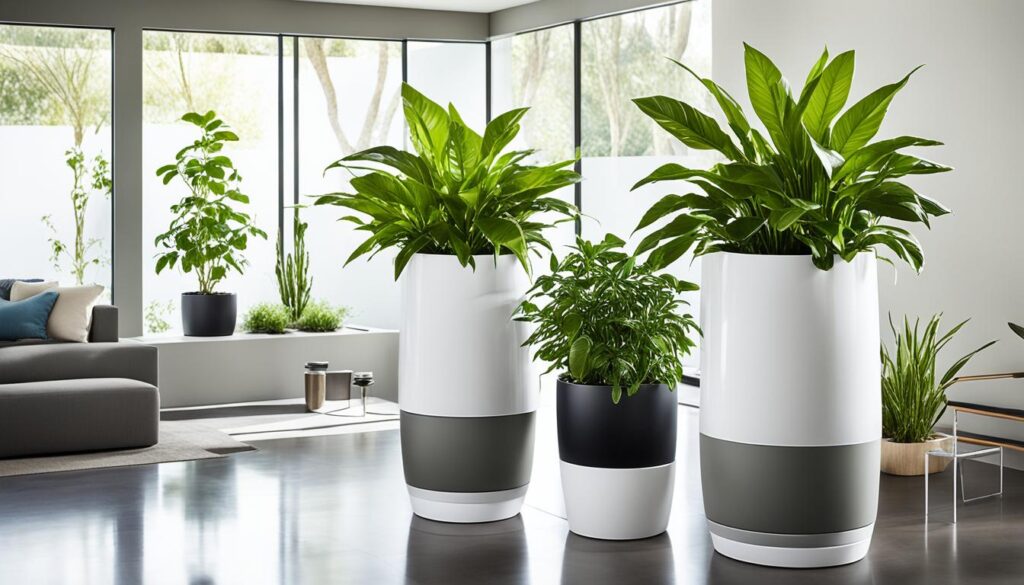
“Self watering planters provide the perfect balance of convenience and beauty, allowing you to effortlessly bring the joys of gardening into your home or outdoor spaces.” – Emily Green, Horticulture Specialist
The Convenience of Self-Watering Planters
Self watering planters offer the convenience of automated watering, reducing the need for constant monitoring and manual watering. With these planters, you can enjoy lush greenery without the stress and effort of traditional watering methods. Whether you have a busy schedule, travel frequently, or simply want to simplify plant care, self watering planters are a game-changer. They ensure your plants stay healthy and vibrant even when you’re not around to tend to them.
| Benefits of Self-Watering Planters | Conventional Watering Methods |
|---|---|
|
|
Self watering planters provide an automatic plant watering system that takes care of your plants’ hydration needs. With a self-watering reservoir, these planters deliver the optimal amount of water directly to the plant’s roots, ensuring they stay hydrated without the risk of overwatering. This efficient watering system not only saves you time and effort but also promotes healthy root growth and minimizes the risk of plant stress or damage.

“Having self watering planters in our garden has made plant care so much easier. We no longer worry about forgetting to water our plants or spending hours manually watering them. The automated watering system ensures our plants thrive, even during busy periods or when we’re away. It’s a true game-changer!” – Sarah, avid gardener.
Self watering planters are available in various styles and sizes, including self watering garden pots, self watering planter boxes, self watering pot for plants, and self watering hanging planters. This allows you to choose the right self watering plant pots that suit your gardening space and aesthetic preferences. Whether you have a small balcony, a spacious backyard, or want to decorate your indoor living area, self watering planters provide a convenient solution.
By investing in self watering containers for your garden or home, you can enjoy the benefits of effortless plant care and maintain beautiful, thriving greenery with minimal effort. Say goodbye to the hassle of manual watering and hello to the convenience of self watering planters.
Choosing the Right Self-Watering Planter for Your Needs
When it comes to selecting the perfect self watering planter, there are a few key factors to consider. By taking into account factors such as size, material, design, and self-watering system, you can ensure that you choose the right planter that meets your specific needs. Here are some important factors to keep in mind:
Size
First, consider the size of the planter. Ensure that it provides enough room for your plants to grow and spread their roots comfortably. Whether you’re looking for a small planter for your kitchen herbs or a larger one for your patio garden, selecting the appropriate size is crucial for the well-being of your plants.
Material
Next, consider the material of the planter. Self watering planters come in a variety of materials, each with its own advantages. Common materials include durable plastics, sleek ceramics, and rustic terracotta. Choose a material that suits your design aesthetic, durability needs, and the specific requirements of your plants.
Design
The design of the planter is also an important consideration. From modern and minimalistic styles to decorative and whimsical designs, there are numerous options to choose from. Select a design that complements your space and adds a touch of personality to your plant display.
Self-Watering System
The self-watering system is the heart of a self watering planter. Look for a planter that has a reliable self-watering system, such as a built-in reservoir and wicking system. This will ensure that your plants receive the optimal amount of moisture without the risk of overwatering or underwatering. Check that the planter’s self-watering system is easy to fill and monitor, allowing you to maintain the right moisture levels for your plants.
By carefully considering these factors, you can choose a self watering planter that not only suits your style but also provides the perfect environment for your plants to thrive.
| Factor | Considerations |
|---|---|
| Size | Choose a planter that provides enough space for your plants to grow and spread their roots. |
| Material | Select a material that aligns with your design aesthetic and the specific needs of your plants. |
| Design | Choose a design that complements your space and adds a touch of personality to your plant display. |
| Self-Watering System | Ensure that the planter has a reliable self-watering system with a reservoir and wicking system for optimal moisture control. |
Planting Recommendations for Self-Watering Planters
When it comes to self-watering planters, choosing the right plants is essential for successful growth. Opting for plants that thrive in consistently moist soil and don’t tolerate drying out between waterings is key. Whether you’re using self watering planters indoors or outdoors, here are some popular plant choices:
1. Dracaena
Dracaena is a versatile plant that adds a touch of elegance to any space. With its striking foliage and low maintenance requirements, it’s a perfect choice for self-watering planters. Dracaenas prefer indirect sunlight and moderate watering, making them ideal for self watering systems.
2. Peace Lilies
Peace lilies are known for their air-purifying properties and beautiful white flowers. These plants thrive in well-draining soil and enjoy consistent moisture. Self-watering planters provide the perfect watering balance for peace lilies, ensuring their lush green foliage and occasional blooms.
3. Herbs
Growing herbs in self-watering planters is a fantastic way to have fresh culinary ingredients at your fingertips. Options such as basil, parsley, thyme, and mint are perfect for indoor self watering herb gardens. These herbs require consistent moisture to thrive, and self watering planters provide the right amount of water for their optimal growth.
4. Shallow-Rooted Vegetables like Peppers
If you’re a fan of homegrown vegetables, self-watering planters can be a game-changer. Shallow-rooted vegetables like peppers thrive in self watering pots due to their continuous water supply. Planting peppers in self-watering planters ensures consistent moisture levels, resulting in healthier plants and abundant harvests.
Remember, while these plants are well-suited for self-watering planters, it’s crucial to understand the specific care requirements of each plant. Pay attention to light levels, temperature, and fertilizing needs to ensure their overall health and well-being.
Conclusion
Self watering planters provide an effortless and convenient solution for maintaining beautiful and healthy plants. With their automated watering system, these planters simplify plant care and ensure optimal moisture levels for plant growth. Whether you lead a busy lifestyle, travel frequently, or simply want to enhance your green thumb, self watering planters are a practical and stylish choice.
By choosing the right self watering planter for your needs, you can enjoy the ease of maintaining a lush garden or indoor green space. These planters offer a hassle-free way to keep your plants thriving, eliminating the need for constant monitoring and manual watering. With a wide variety of options available, including indoor and outdoor planters, you can create a beautiful and sustainable green environment anywhere.
Investing in self watering planters not only simplifies your plant care routine but also contributes to the overall health of your plants. The automated watering system provides consistent moisture, preventing under or overwatering, and allowing your plants to flourish. So, choose self watering planters and experience the joy of effortless greenery.
FAQ
What are self watering planters?
Self watering planters are containers that have a built-in system for watering plants automatically. They provide a convenient and efficient solution for maintaining lush plants without the constant need for manual watering.
How do self watering planter boxes work?
Self watering planter boxes have a self-watering system that mimics natural watering processes. They prevent overwatering or underwatering by storing water in a reservoir and gradually delivering it to the plant’s roots.
Are self watering planters suitable for indoor and outdoor use?
Yes, self watering planters are suitable for both indoor and outdoor gardening. They provide optimal growing conditions for a wide range of plants in various environments.
How long do self watering planters last?
Self watering planters are designed with durability in mind. Made from high-quality materials, they are built to withstand various weather conditions and can last for many seasons.
How easy are self watering planters to use?
Self watering planters are designed for maximum ease of use. With their automated watering system, they eliminate the need for manual watering. Simply fill the reservoir with water, and the system will deliver the right amount of moisture to the plant’s roots.
Can self watering planters be used for both indoor and outdoor gardening?
Yes, self watering planters are suitable for both indoor and outdoor gardening. They can be placed in any convenient location and provide optimal growing conditions for a wide range of plants.
What are the benefits of self watering planters?
Self watering planters offer the convenience of automated watering, reducing the need for constant monitoring and manual watering. They ensure plants stay healthy and vibrant even when you’re not around to tend to them.
How do I choose the right self watering planter for my needs?
When selecting a self watering planter, consider factors such as size, material, and design. Choose a planter that complements your space and provides adequate room for your plants to grow. Also, ensure it has a reliable self-watering system to provide optimal moisture to the plants’ roots.
What plants are recommended for self watering planters?
Self watering planters are recommended for plants that prefer consistently moist soil and do not like to dry out between waterings. Popular choices include dracaena, peace lilies, herbs, and shallow-rooted vegetables like peppers.
Are self watering planters a convenient solution for plant care?
Yes, self watering planters offer an effortless and convenient way to maintain beautiful and healthy plants. With their automated watering system, they simplify plant care and provide optimal moisture levels for plant growth.
With a green thumb and a keen eye for detail, Kayla leads our content with expertise and enthusiasm. Her dedication to spreading the joy of home gardening is reflected in every piece of advice and tip shared. She ensures that our community receives the most reliable and practical gardening insights.
Self Watering Plant Pots
Self Watering Flower Pots Home Depot
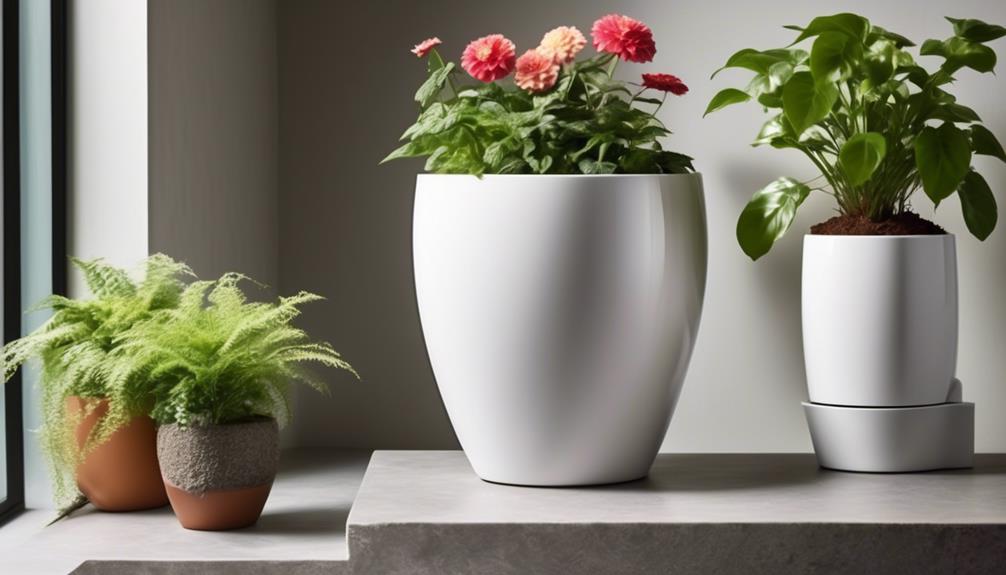
We just picked up some self-watering planters from Home Depot and have been pleasantly surprised at how simple and effective they are to use. As we are always on the go, finding the time to water our plants consistently can be difficult, but these planters have really changed the game for us.
The Home Depot selection was impressive, with a variety of stylish and functional options to choose from. But there's more to self-watering pots than just convenience. Keep reading to discover the benefits and tips for successful plant care that come with using these innovative pots.
Key Takeaways
- Self-watering pots offer a convenient and efficient way to maintain optimal moisture levels for plants, reducing the need for frequent watering.
- They promote healthier root systems and overall plant health by providing a steady flow of water for growth and development, while minimizing the risk of water-related issues such as root rot and fungal infections.
- The choice of pot size and material is important, considering the specific needs of different plant varieties, the retention of moisture, and the ability to withstand constant moisture.
- Self-watering pots are suitable for both indoor and outdoor use, offering convenience, reduced maintenance, and consistent moisture levels. However, outdoor use requires additional considerations such as extreme weather conditions, proper drainage, and adequate sunlight exposure.
Benefits of Self-Watering Pots
We find that self-watering pots provide a convenient and efficient way to maintain optimal moisture levels for plants, reducing the need for frequent watering. This watering efficiency is achieved through a reservoir system that allows the plant to draw water as needed, preventing both overwatering and underwatering. By maintaining consistent moisture levels, self-watering pots promote healthier root systems and overall plant health.
These pots offer several plant health benefits. The controlled water supply ensures that plants receive a steady flow of water, which is essential for their growth and development. This consistent moisture level also helps in preventing stress to the plants, allowing them to thrive.
Additionally, the reduced frequency of watering minimizes the risk of water-related issues such as root rot and fungal infections, further contributing to the well-being of the plants.
How Self-Watering Pots Work
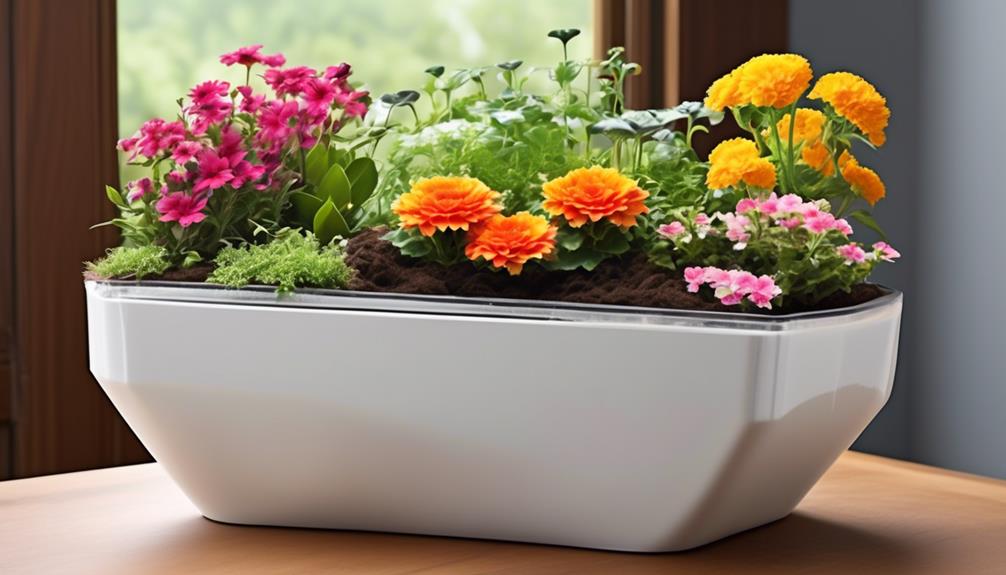
The efficiency of self-watering pots stems from their innovative reservoir system, which allows plants to draw water as needed, maintaining consistent moisture levels to promote healthier root systems and overall plant health. Self-watering pots work through capillary action and a wicking mechanism, ensuring that the soil moisture levels remain constant.
Here's how the watering mechanisms operate in self-watering pots:
- Reservoir: Self-watering pots feature a separate water reservoir at the bottom, equipped with a water level indicator. This reservoir holds the excess water, preventing waterlogging and providing a constant source of moisture for the plant roots.
- Wick or Capillary Mat: The reservoir is connected to the soil through a wick or capillary mat. This wicking mechanism allows the soil to draw water from the reservoir, ensuring that the plant's roots have access to water whenever needed.
- Watering Spout: Some self-watering pots have a watering spout, enabling direct watering into the reservoir, simplifying the process of refilling the water supply.
Understanding the working of self-watering pots and their watering mechanisms is crucial for maintaining optimal soil moisture levels and promoting healthy plant growth.
Choosing the Right Pot Size
Selecting the appropriate pot size is a critical factor in ensuring optimal growth conditions for your plants. When choosing the right pot size, it's important to consider the specific needs of different plant varieties. For instance, plants with deep root systems, such as tomatoes or peppers, require larger pots to accommodate their extensive roots. On the other hand, shallow-rooted herbs like basil or thyme can thrive in smaller pots.
The pot material also plays a role in determining the appropriate size. For example, plastic pots tend to retain moisture better than terracotta pots, so plants in plastic pots may require less frequent watering and can therefore be placed in smaller pots.
It's essential to select a pot that provides ample space for the plant's roots to grow and access water and nutrients, while also considering the overall size of the mature plant. A pot that's too small can restrict root growth and lead to stunted plants, while a pot that's too large can hold excess moisture, potentially causing root rot.
Material Options for Self-Watering Pots
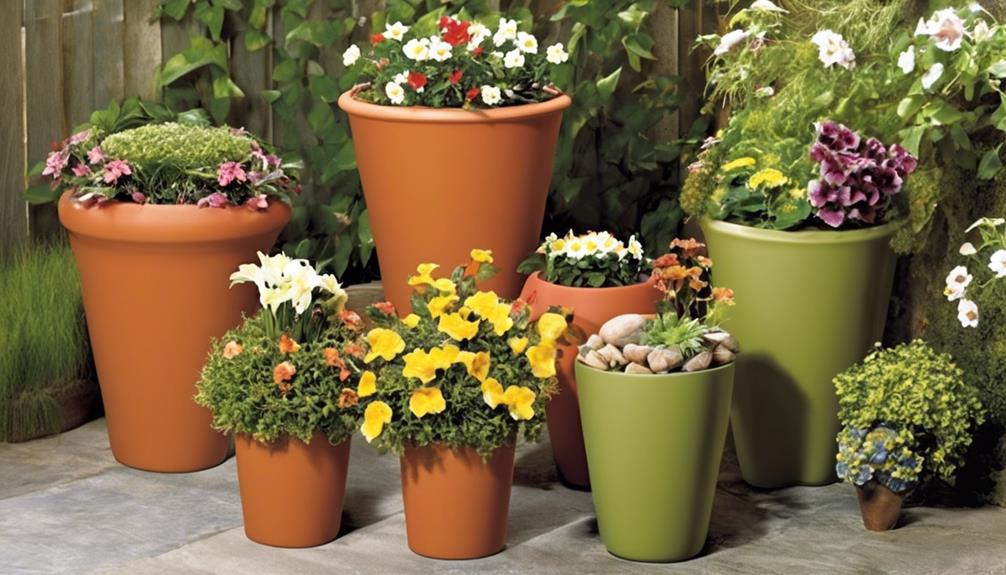
Considering the varying moisture retention properties of different pot materials discussed previously, it's important to evaluate the material options available for self-watering pots. When selecting a material for self-watering pots, several factors should be taken into account, including material durability, aesthetics, environmental impact, and cost-effectiveness.
- Material Durability: Self-watering pots are often subjected to constant moisture, so it's crucial to choose a material that can withstand this environment without deteriorating. Options such as high-quality plastics, fiberglass, and metal alloys offer excellent durability, ensuring the longevity of the self-watering pot.
- Aesthetics: The visual appeal of the self-watering pot is an important consideration. Materials like ceramic and terracotta provide a classic, earthy look, while modern plastics and composites offer a sleek, contemporary appearance. Selecting a material that aligns with the overall aesthetic of the space is essential.
- Environmental Impact and Cost-Effectiveness: Evaluate the environmental impact of the material, considering factors such as recyclability and sustainability. Additionally, weigh the initial cost of the pot against its long-term durability to determine the most cost-effective option. Opting for materials with minimal environmental impact and long-term cost savings is advantageous.
Best Plants for Self-Watering Pots
When choosing plants for self-watering pots, it is essential to consider their water requirements and adaptability to moisture-regulated environments. The ideal plant species for self-watering pots are those that thrive in consistently moist soil and do not require frequent watering. Here are some plant options suitable for self-watering pots:
| Plant Species | Ideal Watering Frequency | Sunlight Requirements |
|---|---|---|
| Peace Lily | Moderate, once a week | Indirect light |
| Spider Plant | Low, once every 10 days | Indirect to bright light |
| Snake Plant | Low, once every 2-3 weeks | Indirect to bright light |
These plants are well-suited for self-watering pots due to their ability to tolerate periods of moist soil without becoming waterlogged. Peace lilies, spider plants, and snake plants are excellent choices for indoor environments and can thrive with minimal maintenance. By selecting plant species with low to moderate watering needs, you can ensure that your self-watering pots provide the right amount of moisture while minimizing the risk of overwatering.
Indoor Vs. Outdoor Use
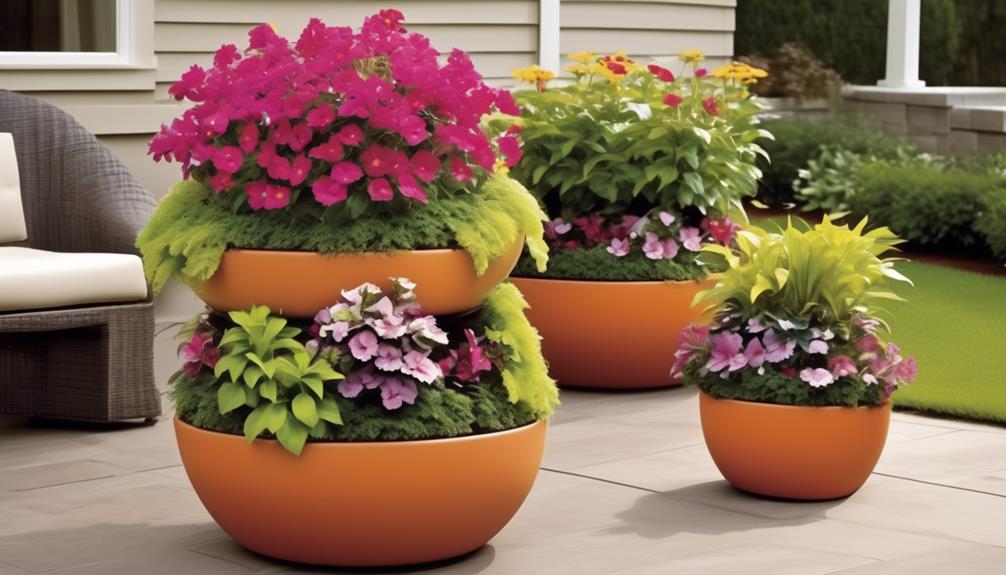
When considering self-watering flower pots for indoor use, we benefit from the convenience of automated watering and reduced maintenance.
However, when using these pots outdoors, we need to consider factors such as exposure to extreme weather conditions and the potential for overwatering due to natural rainfall.
Indoor Benefits
In comparing the indoor and outdoor use of self-watering flower pots, the indoor benefits are notable for their ability to maintain consistent moisture levels for houseplants, promoting healthy growth and reducing the need for frequent watering. When used indoors, self-watering flower pots offer several advantages:
- Indoor Air Purification: These pots contribute to indoor air quality by promoting the growth of houseplants, which naturally filter the air by absorbing pollutants and releasing oxygen.
- Stress Reduction: The low-maintenance nature of self-watering pots reduces the stress of constantly monitoring and watering houseplants, leading to a more relaxed indoor environment.
- Consistent Moisture Levels: Self-watering pots ensure that plants receive consistent moisture, preventing under or overwatering, which is crucial for the health and vitality of indoor plants.
These benefits make self-watering flower pots an excellent choice for maintaining a healthy indoor environment.
Outdoor Considerations
We will now compare the efficacy of self-watering flower pots for outdoor use versus indoor use, focusing on their practical application and benefits in varying environmental conditions.
When considering outdoor use, watering frequency becomes crucial due to varying weather conditions. Self-watering pots can provide a consistent moisture level, reducing the need for frequent watering.
Proper drainage is essential for outdoor self-watering pots to prevent waterlogging, especially during heavy rain. Pot placement is also vital, ensuring that the pots receive adequate sunlight without being exposed to extreme heat or cold. Additionally, outdoor self-watering pots should be designed to withstand UV exposure and outdoor elements.
Maintenance and Cleaning Tips
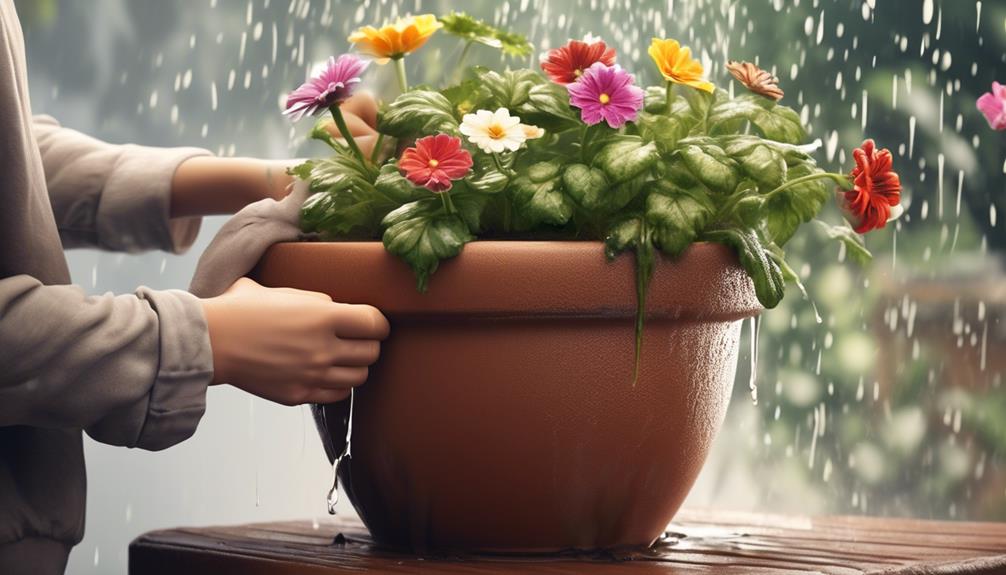
To maintain and clean self-watering flower pots, regularly removing any debris and algae buildup from the reservoir and using a mild soap solution for thorough cleaning is recommended. Proper maintenance and cleaning are essential to ensure the efficient functioning of self-watering flower pots and to promote healthy plant growth. Here are some key maintenance and cleaning tips to help you keep your self-watering flower pots in optimal condition:
- Regular Reservoir Cleaning: Periodically remove any debris, such as fallen leaves or dirt, from the reservoir to prevent clogging and ensure proper water flow to the plants. Use a small brush or sponge to clean the reservoir thoroughly.
- Algae Prevention: Algae buildup in the reservoir can lead to clogs and affect water quality. To prevent this, keep the reservoir area shaded to reduce sunlight exposure, and consider adding a few drops of hydrogen peroxide to the water to discourage algae growth.
- Drainage Maintenance: Check the drainage system regularly to ensure it's functioning properly. Clear any obstructions in the drainage holes to prevent waterlogging, which can lead to root rot and other plant health issues.
Self-Watering Pot Design Features
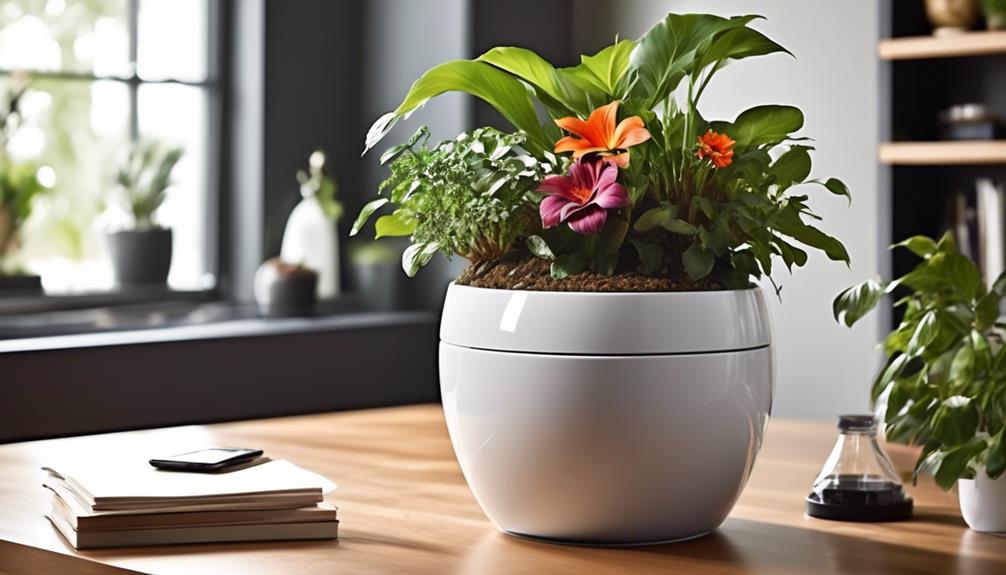
When it comes to self-watering pot design features, two key elements stand out: the pot reservoir function and the water level indicator. These features are crucial in ensuring that plants receive the right amount of water at all times.
The reservoir function allows for water to be stored and released as needed. This means that even if you forget to water your plants for a few days, they will still have access to water through the reservoir. This is especially useful for people who travel frequently or have busy schedules.
The water level indicator provides a visual cue for when it's time to refill the reservoir. It typically consists of a clear tube or window that shows the water level inside the pot. When the water level drops below a certain point, it's a sign that the reservoir needs to be refilled. This helps to prevent overwatering or underwatering of the plants.
Pot Reservoir Function
The pot reservoir in self-watering flower pots functions by storing excess water, which is then absorbed by the plant's roots as needed. This innovative design promotes watering efficiency and reduces the frequency of manual watering.
The pot reservoir operates through a capillary action, allowing the plant to draw water up from the reservoir as required. The following features demonstrate the pot reservoir's functionality:
- Capillary Mat: This specially designed mat allows water to move from the reservoir to the growing medium through capillary action, ensuring consistent moisture levels.
- Water Level Indicator: A transparent gauge indicates the water level in the reservoir, facilitating easy monitoring for timely refills and efficient reservoir maintenance.
- Overflow System: The reservoir includes an overflow mechanism to prevent waterlogging and maintain optimal moisture levels for the plant's roots.
Water Level Indicator
The water level indicator in self-watering flower pots accurately displays the reservoir's water level, enabling efficient monitoring and maintenance. This indicator utilizes water level sensor technology to provide real-time feedback on the water level within the pot's reservoir. Understanding the water level is crucial for proper watering system maintenance, ensuring that plants receive adequate hydration without the risk of overwatering. The table below outlines the functionality of the water level indicator, highlighting its role in maintaining optimal moisture levels for plants.
| Water Level Indicator Features | Description |
|---|---|
| Real-time Monitoring | Utilizes water level sensor technology to display current water levels |
| Maintenance Efficiency | Facilitates efficient monitoring and maintenance of the watering system |
| Prevents Overwatering | Helps prevent overwatering by accurately indicating water levels |
| User-Friendly | Easy-to-read display for user convenience |
| Optimal Plant Hydration | Ensures plants receive adequate hydration for healthy growth |
Understanding Water Reservoirs
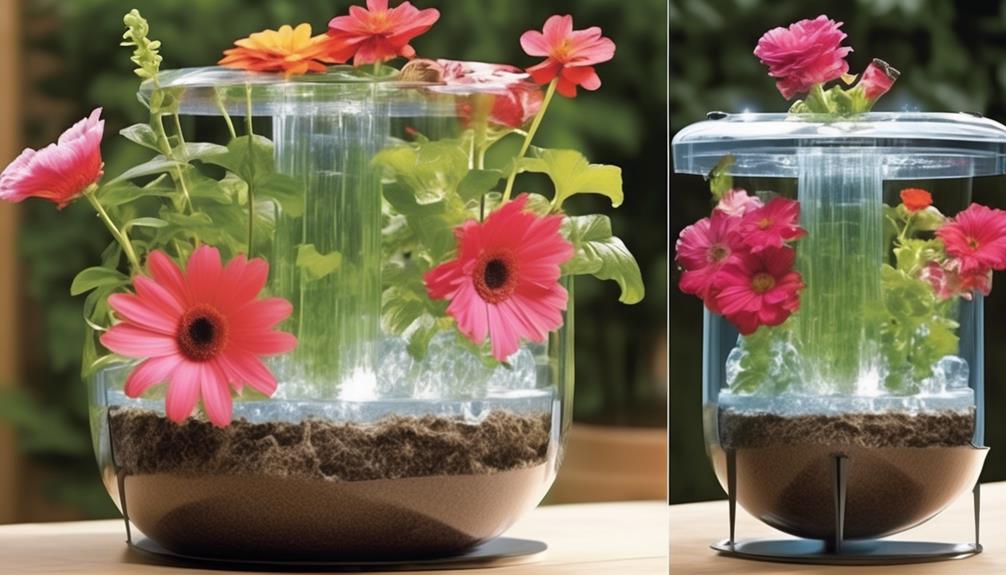
Utilizing a water reservoir in self-watering flower pots allows for efficient and consistent moisture distribution to the plant's roots. Understanding the dynamics of water reservoirs is crucial for optimizing plant hydration and ensuring the effectiveness of the watering system.
- Reservoir Capacity: The size of the water reservoir directly impacts the frequency of refills needed. A larger reservoir can sustain the plant for an extended period, reducing the maintenance required.
- Wicking Mechanism: The water reservoir is connected to the soil through a wicking mechanism, such as a fabric wick or porous material. This mechanism enables capillary action, drawing water from the reservoir to the soil as needed, maintaining an ideal moisture level for the plant.
- Aeration and Drainage: Proper water reservoir design includes provisions for aeration and drainage to prevent waterlogging and root rot. Adequate aeration ensures that the plant roots receive oxygen while avoiding water stagnation.
Understanding these aspects of water reservoirs is fundamental to optimizing the self-watering system's efficiency, promoting healthy plant growth, and minimizing the need for frequent manual watering.
DIY Self-Watering Pot Options
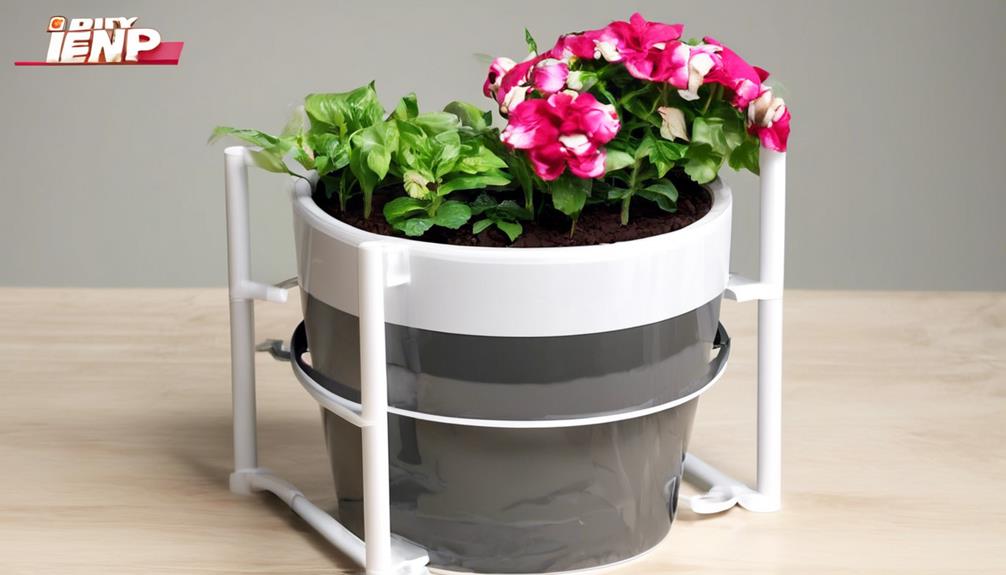
When considering DIY self-watering pot options, it's essential to assess the available materials and their suitability for creating a functional and efficient watering system.
In DIY planter projects, there are various watering system alternatives that can be used to create self-watering pots.
One option is to repurpose plastic bottles by cutting off the bottom and drilling a small hole in the cap. The bottle can then be partially buried in the soil of the planter, allowing it to act as a reservoir for water.
Another alternative is to utilize cotton or nylon ropes as wicks to draw water from a separate reservoir into the soil. This capillary action ensures that the plant's roots receive a steady supply of moisture.
Additionally, using water-absorbent materials such as perlite or vermiculite in the soil mix can help retain moisture and reduce the frequency of watering.
Enhancing Plant Growth With Self-Watering Pots
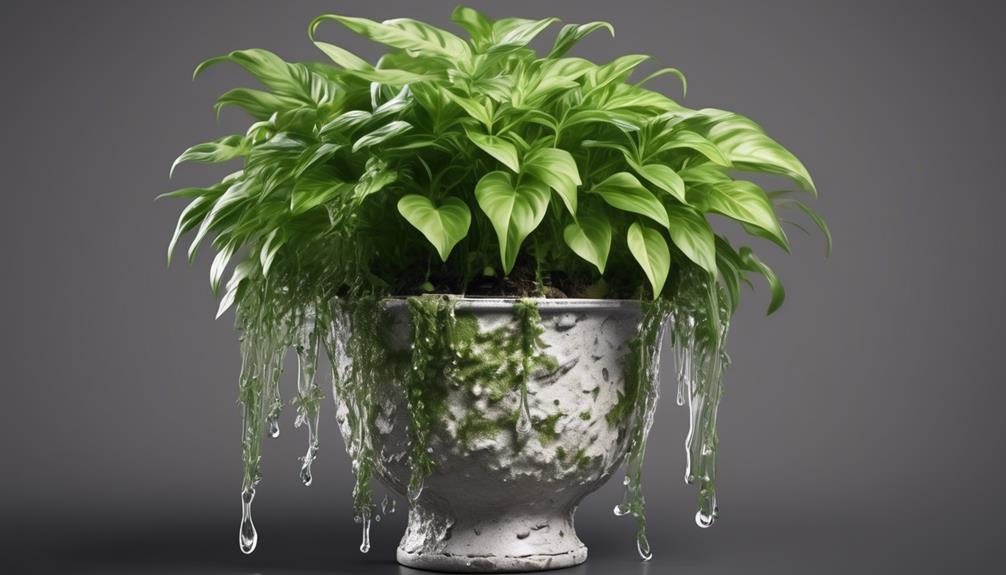
To enhance plant growth with self-watering pots, we can employ a capillary action watering system using nylon ropes to ensure consistent moisture supply to the roots. This method enhances plant hydration by maintaining optimal soil moisture levels, promoting growth enhancement and robust root development. The capillary action of the nylon ropes allows water to move from a reservoir to the potting soil, ensuring a steady supply of moisture to the plant roots. This technique is particularly beneficial for plants that require consistent moisture, such as certain herbs, vegetables, and flowering plants.
Using self-watering pots with capillary action watering systems can significantly improve plant growth and health, making it an effective tool for gardening enthusiasts seeking to optimize their plant care routine.
Benefits of Capillary Action Watering System:
- Consistent Moisture Supply: Ensures a steady and reliable source of water for the plant roots.
- Enhanced Plant Hydration: Maintains optimal soil moisture levels, promoting healthy growth.
- Improved Root Development: Facilitates robust root systems, leading to stronger and more resilient plants.
Self-Watering Pots for Busy Lifestyles
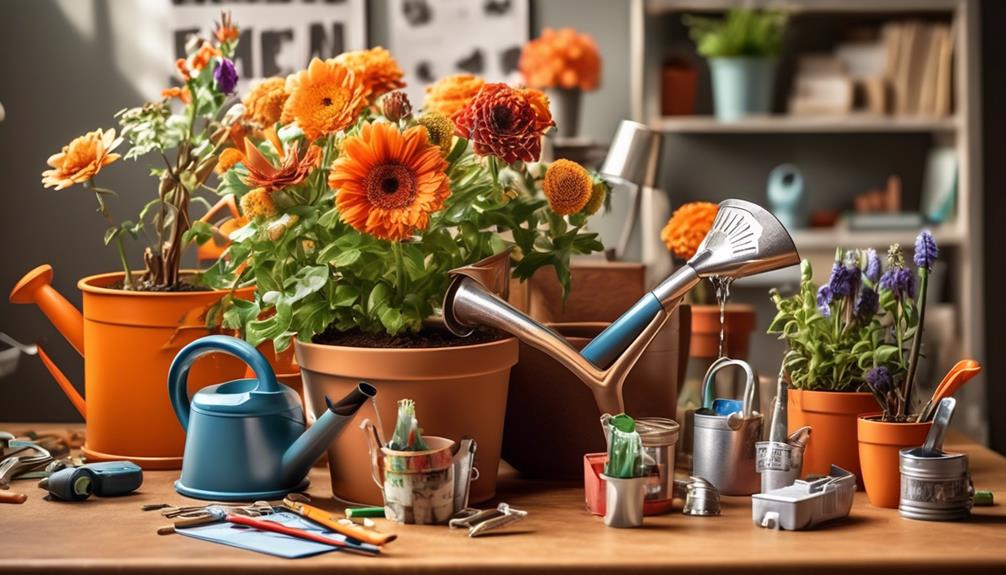
Self-watering pots offer a convenient solution for maintaining plant hydration, particularly beneficial for individuals with busy lifestyles. These innovative containers feature a built-in reservoir that automatically waters the plants based on their specific needs, eliminating the need for a strict watering schedule. For those of us with hectic schedules, these pots provide an ideal solution for ensuring that our plants receive adequate moisture without the constant monitoring and manual watering required by traditional pots.
The self-watering mechanism functions by allowing the plant to draw water from the reservoir as needed, ensuring a consistent level of hydration without the risk of overwatering or underwatering. This is achieved through a wicking system or a water level indicator, which provides real-time feedback on the water status within the pot, allowing for timely refills.
For individuals leading busy lives, self-watering pots not only simplify the process of plant care but also promote healthier and more resilient plant growth. With these pots, maintaining optimal plant hydration becomes effortless, enabling us to enjoy the benefits of greenery in our homes or offices without the added stress of adhering to a strict watering schedule.
Stylish and Functional Options at Home Depot
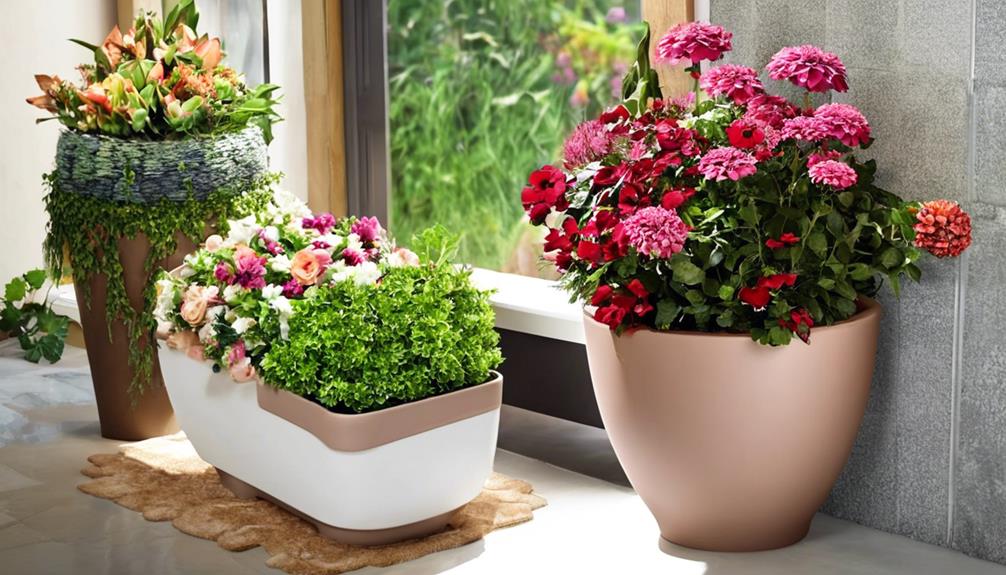
We've discovered that Home Depot offers a diverse range of self-watering flower pots that combine both style and functionality.
These options provide innovative design features, such as built-in water reservoirs and wicking systems, to ensure efficient plant care solutions.
Design and Functionality
With a wide array of stylish and functional options available at Home Depot, the self-watering flower pots provide both aesthetic appeal and practicality for home gardening enthusiasts. These pots are designed to enhance the beauty of plants while ensuring optimal watering efficiency. The following features make them stand out:
- Sleek and Modern Designs: Self-watering pots at Home Depot come in various modern designs, adding an aesthetic touch to any indoor or outdoor space.
- Efficient Watering System: These pots are equipped with a self-watering mechanism that ensures plants receive the right amount of water, promoting healthy growth and reducing water wastage.
- Durable Construction: Made from high-quality materials, these pots are built to withstand the elements, providing long-lasting functionality and visual appeal.
Home Depot's self-watering flower pots offer a harmonious blend of style and functionality, catering to the needs of discerning gardeners.
Plant Care Solutions
The innovative designs and water-efficient functionality of the self-watering flower pots available at Home Depot seamlessly integrate with a range of stylish and functional plant care solutions ideal for home gardening.
When considering plant care solutions, it's essential to address watering frequency and soil moisture to ensure optimal growth and health of plants. The use of self-watering pots, combined with moisture-retaining soil mixes and automatic watering systems, can help maintain consistent soil moisture levels, reducing the need for frequent manual watering.
Additionally, incorporating moisture meters and humidity trays can further aid in monitoring and managing soil moisture. At Home Depot, these plant care solutions are designed to provide mastery over watering practices, enabling home gardeners to achieve efficient and effective plant care while enhancing the aesthetic appeal of their indoor or outdoor spaces.
Tips for Successful Plant Care
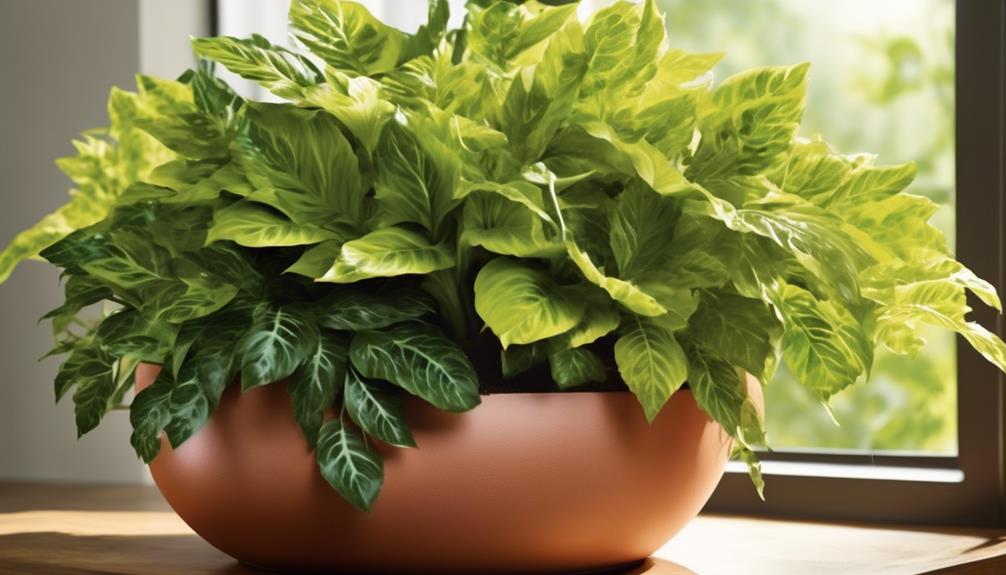
To ensure optimal growth and health of your plants, it's essential to follow a consistent watering schedule and maintain proper soil moisture levels. Proper plant care requires attention to detail and a scientific approach. Here are some tips for successful plant care:
- Watering Frequency: Different plants have varying water needs. It's crucial to research and understand the specific watering requirements of each plant species. Factors such as the plant's size, growth stage, and environmental conditions influence the frequency of watering. For instance, some plants may require daily watering, while others thrive with less frequent watering.
- Soil Moisture Monitoring: Regularly check the moisture level of the soil to ensure it's neither too dry nor overly saturated. Use a moisture meter or simply insert your finger into the soil to gauge its moisture content. Maintaining proper soil moisture is vital for nutrient uptake and overall plant health.
- Consistent Watering: Establishing a consistent watering routine is key to promoting healthy root development and preventing stress to the plants. Consistency in watering helps maintain the ideal balance of air and water in the soil, fostering optimal conditions for plant growth.
Adhering to these plant care practices will contribute to the overall well-being and vitality of your plants.
Frequently Asked Questions
Can Self-Watering Pots Be Used for All Types of Plants, Including Succulents and Cacti?
Yes, self-watering pots can be used for all types of plants, including succulents and cacti. However, it's essential to adjust the watering frequency for these plants.
Succulents and cacti require less water than other plants, so it's crucial to monitor the moisture levels and adjust the self-watering system accordingly.
Overwatering can lead to root rot and other issues, so it's important to tailor the watering schedule to the specific needs of these plants.
Do Self-Watering Pots Require a Specific Type of Soil for Optimal Plant Growth?
For optimal plant growth, the soil composition in self-watering pots is crucial. It must balance water retention and aeration to support root health.
The watering frequency and pot size also affect the soil's performance. The soil should allow efficient water distribution, preventing waterlogging or dryness.
Achieving this balance promotes healthy plant growth. Therefore, selecting the appropriate soil composition and understanding its interaction with watering frequency and pot size is essential for successful cultivation in self-watering pots.
Can Self-Watering Pots Be Used in Areas With Extreme Temperatures, Such as Hot Summers or Cold Winters?
Yes, self-watering pots can be used in areas with extreme temperatures. These pots help regulate watering frequency, providing consistent moisture levels to plants even in hot summers or cold winters.
The benefits include reduced watering frequency and improved plant growth. However, drawbacks may include the potential for waterlogging in extremely hot temperatures. It's important to monitor the moisture levels and adjust as needed to ensure optimal plant health.
Are Self-Watering Pots Suitable for Use With Fertilizer or Plant Food, and if So, How Often Should It Be Added?
Yes, self-watering pots are suitable for use with fertilizer or plant food. Adding fertilizer to the water reservoir can provide essential nutrients to the plants.
The frequency of adding fertilizer depends on the specific needs of the plant and the type of fertilizer used. Generally, it's recommended to add fertilizer to the water every 2-4 weeks during the growing season.
This ensures that the plants receive the necessary nutrients for healthy growth.
Can Self-Watering Pots Be Used in Conjunction With a Drip Irrigation System for Larger Plant Arrangements?
Yes, self-watering pots can be used in conjunction with a drip irrigation system for larger plant arrangements.
The compatibility lies in the ability to regulate the watering frequency, ensuring the plants receive consistent moisture.
This combination offers a precise method for delivering water to the plants, promoting healthy growth and reducing the need for manual watering.
It's an efficient solution for maintaining optimal moisture levels in larger plant arrangements.
What are the Benefits of Self-Watering Flower Pots from Home Depot?
Home Depot’s selfwatering plant pots in green and blue merge functionality with style, offering consistent hydration for thriving blooms. Say goodbye to over or under-watering and hello to vibrant, worry-free gardens that keep your foliage lush while adding a pop of color to your decor.
Conclusion
In conclusion, self-watering flower pots from Home Depot offer a convenient and effective solution for busy plant lovers. With their innovative design and stylish options, these pots make it easy to maintain healthy and thriving plants.
Whether you're a novice gardener or an experienced plant enthusiast, self-watering pots provide a low-maintenance way to keep your greenery flourishing. So, why not add a touch of modern convenience to your gardening routine?
With a green thumb and a keen eye for detail, Kayla leads our content with expertise and enthusiasm. Her dedication to spreading the joy of home gardening is reflected in every piece of advice and tip shared. She ensures that our community receives the most reliable and practical gardening insights.
-
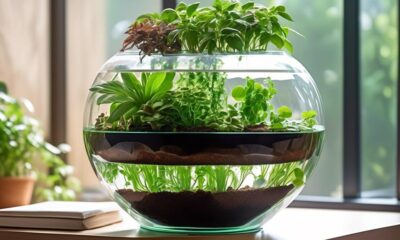
 Self Watering Plant Pots2 weeks ago
Self Watering Plant Pots2 weeks agoHow Do Self Watering Planter Pots Work
-

 Vetted2 weeks ago
Vetted2 weeks ago15 Best Terrace Planters to Elevate Your Outdoor Space
-
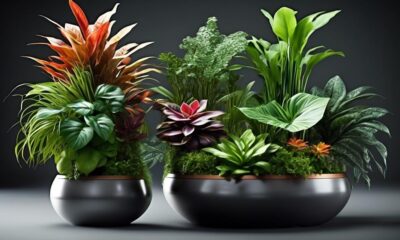
 Vetted2 weeks ago
Vetted2 weeks ago15 Best Self-Watering Pots to Keep Your Plants Thriving
-
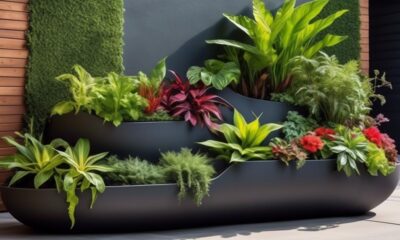
 Vetted2 weeks ago
Vetted2 weeks ago15 Best Wicking Planters to Keep Your Plants Thriving and Healthy
-

 Vetted2 weeks ago
Vetted2 weeks ago15 Best Waterwick Pots to Keep Your Plants Thriving and Healthy
-
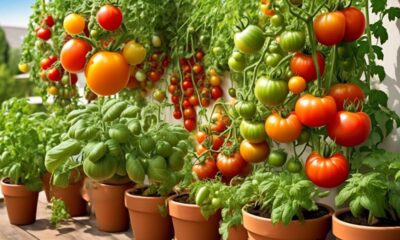
 Vetted2 weeks ago
Vetted2 weeks ago15 Best Tomato Pots for Growing Perfect, Juicy Tomatoes at Home
-
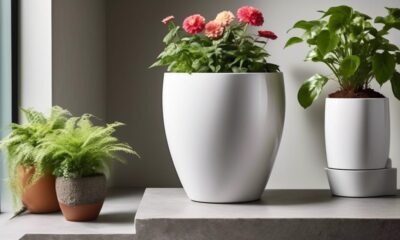
 Self Watering Plant Pots2 weeks ago
Self Watering Plant Pots2 weeks agoSelf Watering Flower Pots Home Depot
-
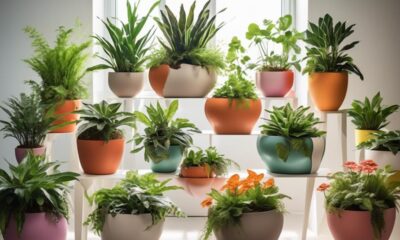
 Vetted2 weeks ago
Vetted2 weeks ago15 Best Self-Watering Inserts to Keep Your Plants Thriving With Minimal Effort











